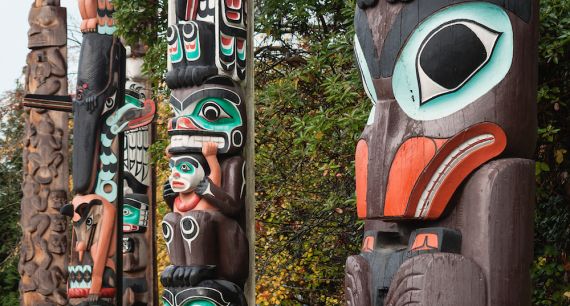The Asia Pacific Foundation of Canada’s Guidebook for Doing Business in the Asia Pacific: A Resource for Indigenous Businesses is a unique online resource created to help catalyze Indigenous business engagement with the Asia Pacific. Supporting Indigenous community and social goals, the Guidebook:
- Explores why opportunities in the Asia Pacific are increasingly important for Indigenous Canada
- Provides an outline for the creation of successful Indigenous Canada-Asia Pacific business strategies
- Consolidates and details the financial, logistical, planning, and networking supports available for doing business in the Asia Pacific
This guidebook – the first of its kind in Canada – is intended to be a resource for Indigenous businesses interested in importing and exporting goods and services and attracting investment. Indigenous entrepreneurs, Indigenous-owned small, medium, and large enterprises, and economic development corporations will find useful information here, whether they are non-exporters in exploratory stages, or more experienced international players looking to expand or attract investment.
The guidebook can help you prepare for visits from Asia Pacific stakeholders or for your Asia Pacific in-market endeavours. There are introductions to topics like exporting 101, networking, financing, and cross-cultural business, along with links to external resources like websites, tools, and guides that can provide deeper dives into further understanding the opportunities, challenges and approaches to Asia Pacific business engagement.
APF Canada's Guidebook for Doing Business in the Asia Pacific: A Resource for Indigenous Businesses is available as a downloadable PDF (above), and as an online document (below).
Using the Guidebook
What Will it Provide? Who is it For?
This guidebook is intended to be a resource for Indigenous businesses interested in doing business with the Asia Pacific region, specifically importing and exporting goods and services and attracting investment. Given the diversity of Indigenous communities in Canada (First Nations, Métis, Inuit) and in type, size and sector of Indigenous businesses in Canada, this guidebook focuses on general considerations and resources rather than the details of how a particular business or community should or should not engage, although many of the resources introduced in this guidebook can assist in answering such inquiries.
Indigenous entrepreneurs, Indigenous-owned small, medium, and large enterprises, and economic development corporations will find useful information here, whether they are non-exporters in exploratory stages, or more experienced international players looking to expand or attract investment. The guidebook – or parts of it – may be shared with chief and council, your board of directors, and/or managers to present the case for engaging with Asia Pacific businesses. The guidebook can help you prepare for visits from Asia Pacific stakeholders or for your Asia Pacific in-market endeavours. There are introductions to topics like exporting 101, networking, financing, and cross-cultural business, along with links to external resources like websites, tools, and guides that can provide deeper dives into further understanding the opportunities, challenges and approaches to Asia Pacific business engagement.
Navigating the Guidebook
The guidebook can be read as a whole document. Online, you can use the chapter navigation at the top of this page to jump to the relevant section(s) for your interests and needs. You also can download a PDF of the whole report (See button above), or of the three sections here: Why the Asia Pacific?; Background, Best Practices, and Winning Strategies for Indigenous Exporters; and, Tips, Tactics, and Resources for Success.
Section 1: Introduction provides an overview of the guidebook and presents the case for why doing business in the Asia Pacific might be a viable and fruitful option for your community to meet its social, cultural and economic goals. Section 2: Background, Best Practices and Winning Strategies for Indigenous Exporters provides a narrative introduction to the opportunities, challenges, and approaches to doing business with the Asia Pacific. Section 3: Tips, Tactics, and Resources for Success provides more detailed information on specific topics and lists of actionable resources focused on different topics of interest, like industry information or cultural guides.
Throughout, the guidebook will help answer the following questions for Asia-interested Indigenous businesses, economic development corporations, and communities, to help grow their presence in the Asia Pacific:
- What government resources are there in Canada and abroad?
- What non-government resources and organizations are available?
- What Indigenous resources are available for aiding in Asia Pacific expansion?
- Where are the obstacles and opportunities for potential Asian investment, business, or trade?
Executive Summary
The Asia Pacific Foundation of Canada presents the Guidebook for Doing Business in the Asia Pacific: A Resource for Indigenous Businesses. This resource aims to help catalyze Indigenous business engagement with the Asia Pacific region.
The Asia Pacific is a dynamic region that accounts for the largest portion of the global population and global Indigenous population, and will soon account for most of the global economy, middle class, and ultra-wealthy people. The region has a large interest in Indigeneity, not only among their own Indigenous populations, which are becoming more prominent, but also among other countries like Canada. Historical similarities including colonialist patterns and cultural similarities between the Asia Pacific and Indigenous Canadians can provide the grounds for deep engagement. A long history of Indigenous globalism and recent institutional changes have made it increasingly opportune for Indigenous businesses in Canada to enter the global economy with specific attention to the Asia Pacific. The resources and economic development goals that Indigenous peoples have and the diverse industries they operate in – such as energy, natural resources, agriculture, fish and seafood, the arts, tourism, and digital/technology economies – are complimentary with increasing demand from the Asia Pacific region.
Indigenous peoples are the fastest-growing demographic in Canada and have significant economic potential. There were 55,255 First Nations, Métis and Inuit -owned businesses in Canada in 2016 spread across every province and territory in a wide variety of sectors; this is an increase from 43,000 in 2011 and from 37,445 in 2006. According to one survey, these businesses export at a greater rate than the average Canadian business, and for each dollar lent under the Aboriginal Business Financing Program, C$3.60 is added to the Canadian GDP.
Despite these positive indicators, going global can be a challenge for Indigenous businesses and communities, especially when acting independently. Obstacles include capacity, having the experience to properly plan and prepare, accessing financing and support programs, understanding and engaging with other cultures, and utilizing resources for business purposes that are in line with community goals. Indigenous nations have many assets, but they can also be challenging to utilize and make doing business difficult. For example, the organizational structure of nations can make it quicker and easier to do some projects, and stall others. Overcoming the many obstacles and challenges is important, as connecting to the global economy is often seen as the next step to Indigenous economic development, which itself is a key to reconciliation.
The guidebook covers some general strategic considerations. For example, co-operation among Indigenous businesses and nations to increase their communications abilities, represent their interests, build partnerships, and increase autonomy in the global economy may help overcome some of the mentioned challenges. Many Indigenous businesses have deep experience in Canada and the United States, which is a positive predictor of success overseas among other factors like having a business plan. For a successful crosspacific partnership, you will have to learn the formal and cultural aspects of doing business in Asia, just as your partners will have to when in Canada. The importance of cultural competency cannot be overstated.
There are many resources and tips to help you, but the outlook on going global should be one of cautious optimism. Different business strategies may work differently for different businesses and nations, bringing to light positives and negatives that may be difficult to foresee. And just as many studies have taught us, like the insightful Harvard Project on American Indian Economic Development, access to all manner of resources and having a plan does not guarantee success. Success hinges on internal factors such as the thoughtful leadership of an enterprise or making hard decisions for the long-term that run counter to the immediate struggles of nations, like spending money on international travel or spending large amounts of time on proposals. This guidebook will not discuss how those decisions should be made or how difficult it will be. Nor is it a how-to guide for every possible configuration of potential Asia engagement.
This guidebook details the many financial, logistical, planning, networking, and Indigenous business supports for doing business and strategizing with the Asia Pacific. It shows which federal and provincial programs and offices, business associations, and Indigenous organizations might be able to help minimize risks and maximize successful engagement in Asia Pacific markets, and can help address some of the obstacles and challenges mentioned. By capitalizing on their resources, cultural and historical similarities, and overlapping goals, Indigenous businesses can be leaders in engagement and seizing opportunities in the Asia Pacific on their own terms.
Introduction
Why the Asia Pacific?
There are many reasons that Indigenous people in Canada might be interested in developing or increasing engagement with the Asia Pacific region. Whatever your strategic considerations, the Asia Pacific region will come to play an increasingly important role in the future.
Asia Pacific Is Diverse and Its Population Is Growing
There are around 50 economies in the Asia Pacific that account for more than half of the world’s population and a third of the world’s languages.
There is a mix of developed (e.g. Japan, Australia) and developing and emerging economies (e.g. India). Demographically, there are economies that are aging (e.g. Hong Kong, Japan, Singapore, South Korea, Taiwan), those with youth bulges (e.g. India, Indonesia, Malaysia, Pakistan, the Philippines), and those somewhere in between (e.g. China).
Like elsewhere in the world, urbanization is on the rise and the region is home to the world’s largest and fastest-growing cities; over half of the cities with a population of five million people or more are in the Asia Pacific.
The Asia Pacific is also home to an estimated 70% of the global Indigenous population of approximately 370 million, many of whom are interested in or are already actively participating in the global economy.

Asia Pacific Fuels the Global Economy
The region continues to be the main source of global economic growth; it already accounts for the world’s largest share of gross domestic product (GDP) in current prices and adjusted by purchasing power parity (PPP).

Source: IMF DataMapper, "GDP based on PPP, share of the world."
The region will account for half of the world’s middle class by 2020 and already has the largest portion of the world’s ultra-wealthy people or so-called high net worth individuals (HNWI) both in terms of population and wealth.

Source: IMF DataMapper, "GDP based on PPP, share of the world."

Source: Capgemini (2019), World Wealth Report.
Asia Pacific adds millions of new middle-class consumers each year, who are raising demand for energy and clean energy products, agricultural and food products, services, and are increasingly interested in tourism and cultural products from Canada’s Indigenous peoples.

Source: Hoimi Kharas (2017), The Unprecedented Expansion of the Global Middle Class. Brookings Institute.
The economies and businesses in the region have demonstrated interest in Canadian and Indigenous products, resources, and services, and they often view Canadian products and services as safe, reliable, and of high quality.
Less is known on the current engagement of Asia Pacific stakeholders with Indigenous businesses and communities in Canada, but anecdotal accounts from across the country suggest significant and growing interest in Indigenous Canada from the Asia Pacific.
While all this paints a rosy picture of opportunities in the Asia Pacific, business engagement can be far from easy or straightforward. Many of the Asia Pacific businesses that are engaged internationally are large or even massive conglomerates or state-owned enterprises, while most Indigenous businesses in Canada are micro to small in size. The Asia Pacific is the most diverse and dynamic region in the world; many of the markets are complex, filled with competitors from around the world, and difficult even for established Canadian companies to navigate.
That being so, working to address some of the increasing needs, desires, and opportunities arising from the Asia Pacific can be one means for ready and well-prepared Indigenous businesses to meet their community, social, and economic goals, and seize growth in the region.
Background, Best Practices, and Winning Strategies
Now is the Time for Indigenous Exporters
Entering the global economy on their own terms is a key factor to future Indigenous economic development, and the Asia Pacific region holds particular promise. Participating in the global economy can be done in a way that allows traditional lands, culture, history, and values to play a large role. Globalization can allow Indigenous cultural distinctiveness to survive and thrive by allowing direct marketing and political connections to international actors, in contrast to the common position that globalization reduces cultural diversity. [1] Indigenous peoples have a strong history of global trade, relations, and engagement, but changes to today’s modern institutions, norms, and supports have made it easier for Indigenous communities and businesses to conduct these activities. These changes include:
- The 1989 International Labour Organization Convention 169 (building off its predecessor Convention 107 from 1957) aims to improve living conditions of Indigenous peoples through recognition and respect for Indigenous customs, institutions, and rights;
- The World Bank and regional development banks such as the Asian Development Bank have specific Indigenous policies and safeguards to help foster respect of Indigenous peoples and ensure their active and beneficial participation in projects that affect them;
- The 2007 United Nations Declaration on the Rights of Indigenous Peoples (UNDRIP) is supported by most of the world's countries and is the most comprehensive international instrument on Indigenous rights and standards;
- A myriad of court cases in various jurisdictions have ruled in favour of Indigenous rights, title, and claims;
- The Truth and Reconciliation Commission of Canada's calls to action that address education (62-65), professional development (57), and business (92); and
- A new focus in Canada on inclusive trade has resulted in changes to the United States-Mexico-Canada Agreement (USMCA, formerly NAFTA), [2] the June 2019 joint Canadian Council for Aboriginal Business (CCAB)-Global Affairs Canada (GAC) report and recommendations on Indigenous exporting, and a Canadian government announcement of expanded trade services for Indigenous business.
While much work needs to be done, these all speak to the long-term sustained global efforts by Indigenous people for domestic and international economic inclusion.
Indigenous peoples are the fastest growing demographic in Canada and have significant economic potential – the Canadian Indigenous economy was worth an estimated C$32B in 2016 and is growing. There were 55,255 First Nations, Métis and Inuit -owned businesses in Canada spread across every province and territory in a wide variety of sectors in 2016, up from 43,000 in 2011 and 37,445 in 2006. [3]

Most recent calculations estimate that Indigenous firms are both innovating and exporting at rates higher than the national average. With some caveats on sample size, a joint Global Affairs Canada–CCAB survey report found that while 11.8% of Canadian SMEs export, 24.4% of Aboriginal-owned businesses are exporting. Exporting goods or services matters for businesses because according to Export Development Canada "companies that export make 121% more money, grow faster, last longer, are better connected within supply chains, are more resilient to economic downturns, and are more productive, competitive and innovative." For each dollar lent under the Aboriginal Business Financing Program, a key nation-wide financial tool for Indigenous business, C$3.60 is added to the Canadian GDP.
Regardless of the reported high rate of exporters among Indigenous-owned businesses, the fact remains that most do not export to international markets outside the United States. Among those that do export, 9.6% export only to the United States, 11.9% export to both US and international markets, and 2.9% export only to international markets outside the United States. While less is known on the portion of Indigenous businesses and entrepreneurs that are presently in or interested in Asia Pacific markets, recent activities ranging from roundtables on the topic to government and private sector trade missions and events show wide-ranging serious interest in the region. [4]
Going global can be a challenge for Indigenous businesses and communities, especially when acting independently. Obstacles include access to financing and support programs, understanding and engaging with other cultures, and utilizing resources for business purposes. The structure of Indigenous nations can be an asset, but it can also make doing business difficult. Strategies may work differently for different business and nations and bring to light positives and negatives that may be difficult to foresee. And just as many studies have taught us, like the insightful Harvard Project on American Indian Economic Development, access to all manner of resources and having a plan does not guarantee success. Success hinges on internal factors such as the thoughtful leadership of an enterprise, a lot of hard work over a sustained period of time, or making hard decisions for the long-term that may run counter to the immediate struggles of nations, like spending money on international travel or spending large amounts of time and resources on proposals.
Authors of a 2016 article in the Harvard Business Review reported that in working with more than 100 global organizations over decades, most responded too eagerly to trends like growing middle classes and positive market indicators when entering new markets, like those we see in the Asia Pacific. Many of those businesses stated that they almost did or didn’t at all meet their performance objectives, which the authors attribute to not having their internal pieces in place. In other words, while engaging international markets can be rewarding, doing it successfully, especially in complex markets in the Asia Pacific, requires planning and commitment over the long term. A checklist to see if you are ready to export and your potential for doing so can be found in Section 3, Number 2: Exporting Preparedness Checklist.
Co-operation among like-minded Indigenous businesses and nations to increase their communications abilities, represent their interests, build partnerships, and increase autonomy in the global economy may help overcome some of these challenges – some communities are already doing this for domestic real estate, energy, and resource related ventures. By capitalizing on their resources, cultural and historical similarities, and overlapping goals, Indigenous businesses can be leaders in engagement and seizing opportunities in the Asia Pacific.
Business Support for Indigenous–Asia Pacific Engagement
This section details the government, nongovernment, and business supports for doing business and strategizing with the Asia Pacific. It also highlights the current efforts to work with Indigenous peoples to enter the global economy on their own terms. Despite the many obstacles and challenges, connecting to the global economy is often seen as the next step to Indigenous economic development, which itself is a key to reconciliation.
Government and Non-Governmental Organizational Support

Diversification of Indigenous business toward the Asia Pacific is an important and already growing component for future economic growth. Indigenous peoples and governments are increasingly partnering to lead trade missions from Canada, Australia, New Zealand, Taiwan, and other economies that are seeking to promote and support the integration of their Indigenous populations into the global economy. State governments are increasingly supportive, such as the Australian government, which provides specific programs and support for global Indigenous business and created relevant reports, guides, and a five-year Indigenous strategy in its Department of Foreign Affairs and Trade. The World Indigenous Business Forum, the International Inter-Tribal Trade Organization, and other non-profit organizations are successfully spurring discussion and action on these topics on the world stage, including on more inclusive trade agreements. Opportunities are arising to conduct business between Indigenous nations around the world. There are also an increasing number of opportunities to get Indigenous youth in Canada thinking about and engaged with the Asia Pacific to foster needed competencies, global mindsets, and skills for their future and future Asia Pacific engagement.
The Canadian Trade Commissioner Service (TCS) provides Canadian companies with free on-the-ground intelligence and practical advice on foreign markets to help potential and current exporters make better, more timely, and more cost-effective decisions in order to achieve their goals abroad. As Canada’s largest network of international trade professionals, the TCS has more than 1,000 trade commissioners located around the world.
The TCS can help exporters:
- Pursue and close more export deals;
- Develop market-entry strategies;
- Identify qualified business contacts;
- Resolve complex business problems; and
- Avoid delays and costly mistakes.
In addition, the TCS offers funding programs and support for companies and communities to help them expand their global horizons and grow their communities.
The TCS also has a dedicated team that offers additional support for Indigenous exporters, including trade missions, events, and business delegations for Indigenous companies to connect them with international opportunities. Further information on these activities, as well as links to funding, resources, opportunities, and connections for Indigenous exporters is available on the Indigenous Business Export Support Program web page. For additional Indigenous international business questions or support, please contact the TCS. IndigenousBusiness@international.gc.ca.
Doing business in Asia is not easy. Setbacks and failures in business and trade delegations as a result of not being prepared are common. Some lessons learned are that even if you have funding, an opportunity, and even a physical presence, you may not be able to sell your product or service. You will need to ensure your business is fully prepared and adapted for the market, both internally and externally. It can be difficult to be that prepared and knowledgeable, and that is one reason why there is such a wide variety of resources dedicated to helping Canadian companies abroad, and why programming regularly changes. Trade commissioners, export preparedness checklists, Canadian and Asian business mentorships, and other tools can increase your understanding of markets in the Asia Pacific and increase your odds of success.
Business Support

In addition to these opportunities, there are also economic changes that increase Indigenous opportunity. In today’s global economy, companies are realizing that they must co-operate with communities where their customers and employees live, and successful integration with the global economic system depends on local processes, where “economic structures, values, cultures, institutions and histories contribute profoundly to that success.” [5] Viewing communities as valued members of a system rather than viewing communities as something external to be dealt with is becoming the norm. For this reason, especially as a matter of economic self-interest, large corporations are increasingly supporting community development in Indigenous communities. This means that Indigenous people can enter the global economy on their own terms, where traditional lands, history, culture, and values play a critical role. [6] To do so will require identifying business opportunities and then gathering the resources and developing the organizations and human resources required to meet them.
Accessing Resources

While opportunities in the Asia Pacific for Indigenous businesses and entrepreneurs are growing, difficulties remain. One piece of the puzzle is identifying and accessing resources and program supports. There is a good indication that many Indigenous businesses may be missing out on opportunities for support from a variety of Indigenous and non-Indigenous organizations, as well as government and nongovernment national, provincial and territorial programs and services. For example, according to a CCAB survey, only 4 in 10 Aboriginal business owners report having used a government program, and there was great variety (27) in the types of programs reported being used. The most common programming accessed was related to loans and grants to small companies for financial support for employment-related activities. And how did owners find out about these government resources? The overwhelming majority cited word of mouth (43%) followed by internet search (16%). Despite their track record of success, Indigenous businesses face challenges accessing financing and in other business functions. With that in mind, this guidebook can be used to help find the services and support needed for Indigenous businesses to engage or increase engagement with the Asia Pacific.
And what were the reasons for not using a government resource? According to the CCAB, the top three were: don’t see a need or value in the programs (41%), were not aware of them or they were hard to find (22%), and there was too much bureaucracy involved (16%). While this guidebook might not be able to fully mitigate these concerns, it can help show many programs’ value to your particular endeavour, save you time finding them, and help target your approach to looking for support.
Creating an Indigenous Business Strategy for the Asia Pacific
Regardless of the size or sector of your business, developing an Asia Pacific strategy will help you find new ways of addressing the needs and aspirations of your business, marketing and selling your products or services, and/or attracting investment from the region. Only 3 in 10 Aboriginal businesses in Canada have a business plan, largely due to not seeing a need or not having the resources to develop one. This is despite business plans being integral to many business functions, such as understanding long-term viability and increasing the ability to raise capital, which almost half of Indigenous businesses struggle with. Business plans are especially important to successfully navigate international expansion. This section will describe some of the broad considerations that go into making a strategic plan for seeking and pursuing opportunities in international markets with a focus on the Asia Pacific – and will provide resources available to develop such plans.
There are three components to developing an Asia Pacific strategy: resources, industries, and institutions. Each of these is addressed below. For example, if you are looking to sell a product or service in Asia, you need to consider what competitive advantage you can draw from your resources, what the competitive forces of your product or service are when looking at a particular country or market, and what institutions – such as regulations, trade agreements, and government offices – are relevant. The three components and relevant information are looked at in the following three sections.
Resources
Assessing your resources will help your organization meet the aspirations of your business or community and find and achieve a competitive advantage. Ideally, your resources should be valuable, rare, and hard for others to imitate or implement. Indigenous resources have been and are increasingly sought by businesses and are marketable throughout the Asia Pacific region. This section will discuss Indigenous resources that Asian economies may be interested in, including but not limited to land and culture, energy and natural resources, organizational structure, e-commerce, and agriculture and agri-food.
Land and Culture
Your Resources

Outright exploitation of land and culture and other Indigenous resources for economic gain is not fully compatible with the goals and interests of Indigenous communities. But some communities may find that such resources can be used to help meet long-term Indigenous economic and social goals, such as providing stable employment in the community and encouraging cultural practices through activities like tourism in a particular area or selling art. Land can be developed for economic purposes by being leased, used for production facilities, used for renewable energy production, tourism, and in other ways.
It is difficult to provide a concise overview of Indigenous lands, as there are First Nations reserves, urban reserves, Métis communities, Inuit lands, Indigenous majority communities, and different regulatory and other considerations for each. Different communities will have their own ideas about how to use the resources available to them. In addition, modern land claim agreements and other changes mean that the current situation will continue to change. Briefly, having ownership and management of land can be beneficial for the reasons mentioned, but some Indigenous nations have had difficulty utilizing their land for business development purposes. These challenges can be due to isolation, governance and organizational structures, regulatory environments, and the decision-making process involved, among others. Overcoming these challenges will be unique to each nation or business venture, and rely largely on internal factors, but it is not impossible. If the challenges are overcome or are small to begin with, land development may be one of the easiest-to-access business options.
Indigenous culture is unique to each nation, making cultural products and experiences like art, beadwork, clothing, and local activities especially valuable to people who are interested in purchasing or experiencing them. Over half a million tourists came to Canada from China in 2017 alone, almost one-third of whom have participated in an Indigenous experience, with even more interested in doing so. And there are similar interest rates across Asia Pacific countries. The Indigenous tourism sector is set to capture demand from Asia as the Indigenous Tourism Association of Canada (ITAC) has set a goal of establishing 50 Indigenous tourism companies that are export ready by 2021 and supporting 200 such companies by 2024, and is providing funds of up to C$10,000 per business to spur such growth. ITAC also has information, such as market information and best practices, that may be useful.
Your Opportunities and Challenges
Viewing the Northern Lights, hunting, and other experiences that Indigenous people are well positioned to provide are gaining in popularity among Asian tourists. The Inuit art global market was worth C$64M in 2015, which has been attributed in part to growing demand in Asia resulting from Indigenous-government promotion of Canadian culture in the area. Leveraging cultural products requires identifying one or more markets that value Indigenous cultural goods and services, and taking steps to ensure that there is some form of authentication of the cultural goods or services so that they cannot be imitated or to differentiate from those that are inauthentic. Section 3, Number 12: Dealing with Asian Governments mentions key points to consider regarding protecting your intellectual property and traditional knowledge.
There are some cultural and historical similarities between Indigenous people in Canada and Indigenous and non-Indigenous people in the Asia Pacific. There is a large amount of cultural diversity, a shared colonial history, and common goals like environmentalism and self-determination. Recognizing and embracing the similarities opens the door to a deepened sense of mutual understanding and respect. For some accounts of this shared history, culture, and values, see Section 3, Number 16: Examples of Shared Indigenous-Asian History, Culture, and Values.
[I]n China, culture is very big. It is a land of great culture; great cultures actually [...] On our trips to China, when our regalia and our masks and drums were brought forward, the dynamics of the meeting changed dramatically. It was culture meeting culture. Talking to each other on a cultural foundation about the long history and long traditions and roots of our respective cultures, we are able to talk on that level [...] You are not talking about bottom lines, dollars, and accents. - Grand Chief Edward John [7]
On the flip side, you will still need to deal with language and cultural barriers. Expect to have to deal with translators, local business agents, and learning new languages or at least a few words or phrases. This will be a difficult task that often leads to international business struggles and failures.
Energy and Natural Resources
Your Resources

Indigenous communities have access to vast energy and natural resources and these communities have continually expressed that they are not anti-development. Rather, they want to be included in the dialogue and benefit from development in line with community values, interests, and goals, which often include strong consideration of social, cultural and environmental variables in addition to economic variables. Some experts argue that the energy and resource sector offers the most potential for country-wide Indigenous economic development and that Indigenous participation is key to the sector’s future. Organizations like the Indian Resource Council, the First Nations Major Projects Coalition and the BC First Nations Energy and Mining Council (BCFNEMC) are proof of this.
With many Indigenous people living near oil and gas deposits, mines, forests, lakes and rivers, and other such natural resources, this is a particularly important industry. Most Indigenous businesses in Canada that already do business with Asian companies or Asian-affiliated companies likely do so as part of natural resource agreements. Some other experts have noted that there exists what closely resembles the “resource curse” in certain areas: despite access to natural resources, many Indigenous peoples do not prosper from those resources. However, the industry is changing and is playing an increasingly important role in Indigenous economic development as more integration, effort, and investment is put into ensuring Indigenous peoples receive proper and sufficient consultation, compensation, and opportunities. And new tools are making it easier for government and industry to award resource sector-related contracts to Indigenous businesses.
Your Opportunities and Challenges
Some Indigenous organizations receive regular inquiries from stakeholders in Asia, indicating the opportunities for investment from Asia into Indigenous-owned energy, natural resources, and resource development. As previously mentioned, the majority of Indigenous businesses that have ongoing relationships with Asian stakeholders do so as part of resource agreements. From 2017 to 2018 alone, there were 21 deals totalling C$29.5B invested from the Asia Pacific to Canada in the energy sector, compared to C$19.46B invested from 2003 to 2010. This and other key investment information in several industries between Canada and the Asia Pacific can be found using APF Canada’s Investment Monitor tool.
The Asia Pacific already uses more energy than it produces, with a 75% increase in CO2 emissions in China alone from 2004 to 2012, and by 2035 the region will consume half the worlds energy supply. Another opportunity is to look for additional business spin-offs, for example in managing, servicing, or maintaining any resource investment projects. The Asia Pacific region is also disproportionately affected by climate change, including rising sea levels, increasing storms, and pollution, leading to increased investment from the region into clean tech. Indigenous people value the environment, and the environment in Asia is becoming increasingly stressed, leading to opportunities to collaborate in making the future a cleaner, greener one through clean energy and clean tech. APF Canada’s China Eco-City Tracker sheds light on the environmental indicators in 31 cities in China and can help businesses identify potential opportunities in that market.

A critical component of resource development projects is the duty to consult, accommodate, and negotiate with Indigenous peoples. This is important for Indigenous–Asia Pacific relations because there have been at least a few instances where Asian partners were unaware of this context or believed it to be a domestic rather than an international issue that they need not concern themselves with. Such misunderstandings can cause costly delays, uneasy relations, or even the cancellation of projects.
A BCFNEMC document succinctly describes the duty to consult and accommodate and negotiation practices:
An essential component of resource development in Canada is the legal requirement to consult and accommodate First Nations whose rights might be adversely impacted by the development. Working closely with First Nations and developing partnerships based on trust, respect and recognition of First Nations rights and title will help ensure the successful development and operation of resource-related projects. By building relationships and securing agreements with First Nations, companies will avoid project risks such as costly project delays due to litigation or injunctions, challenges to permits, restriction of access for works and negative media campaigns. Critical aspects of consultation and negotiation with First Nations on resource projects include:
- Open and honest communication throughout all aspects of the project.
- Agreement that the free, prior and informed consent of First Nations must be obtained before developing projects and activities affecting their communities.
- Negotiation of Impact and Benefit Agreements that include profit sharing, equity, and other social and economic provisions.
- Resource development must be conducted in an environmentally, ecologically, socially, culturally, economically sustainable and viable manner for the benefit of future generations.
- The inclusion of Indigenous knowledge throughout the planning and development of a project.
- Financial resources for the First Nations to engage in the consultation and negotiation process.
- Education, training and capacity to ensure full participation in the planning, construction and operations of a project.
Preparing to discuss such practices and resource participation models with Asian stakeholders can help your potential partners understand the Indigenous community and business context and reduce risks.
Agriculture and Agri-food

Your Resource
The CCAB argues that there is significant potential for Indigenous businesses to grow in the agriculture and agri-food sector, a sector which currently has an underrepresentation of Indigenous businesses despite access to land, water, and sea. In 2016, 30% of Indigenous agriculture businesses exported, almost triple the Canadian average. Indigenous businesses produce and have potential to produce a wide variety of agriculture and agri-food products suitable for Asia Pacific markets, ranging from common to more traditional and niche grains, fruit, vegetables, meat, freshwater fish, and seafood products.
Your Opportunities and Challenges
With the growing economy and middle class in Asia, and the high regard for safe, high-quality, and niche/specialty Canadian agricultural products, Indigenous peoples with these resources or the potential to develop them have an opportunity. With increasing governmental support, including Indigenous funding, participation and skills development, and support for trade with Asia, it is increasingly easy to conduct business and trade in this sector. China is an especially large market for agri-food and seafood products, and many of these items are increasingly sold on e-commerce platforms like Alibaba, but it comes with its own set of tariff and nontariff barriers that can be arbitrarily imposed, and it is by no means the only market. Trade in agriculture, agrifood, and seafood between Canada and the Asia Pacific region has increased by 300% since 2010, indicating the rapid growth in opportunities. However, as recent spats with China and India over canola, pork, and pulses have shown, a large market does not necessarily correlate with ease of doing business, and these are difficult markets to engage. These products rely heavily on the Canadian reputation or brand for safe and quality products and investment.
The Comprehensive and Progressive Agreement for the Trans Pacific Partnership (CPTPP) now gives Canadian products in this sector preferential treatment in member countries, which includes Japan, Vietnam, Malaysia, Australia, and New Zealand, and the Canada-Korea Free Trade Agreement reduces or eliminates tariffs on exports to that market. The CPTPP allows Canadians to provide many other products with reduced tariffs, which provides them a competitive position over other major exporters like the United States. The CPTPP provides a variety of other benefits and advantages, including reducing non-tariff barriers to trade.

Organizational Structure

Your Resources
The organizational structures of Indigenous organizations have potential to provide an ease of doing business that other businesses cannot. Self-governing Indigenous nations that have jurisdictional control may play a stronger role in development within their territories. In theory this could translate into making it easier to navigate the regulatory environment and to access key decision-makers and take less time to approve and scale projects. Some Indigenous nations have their own independently governed economic development corporations. Being independently governed can help minimize business risk, and therefore these businesses make attractive partners.
Indigenous cultures typically lend to a long-term orientation, meaning that Indigenous peoples generally think about the long-term consequences of business decisions today, and might prefer long-term relationships rather than focusing on short-term business dealings. Many countries in the Asia Pacific have a similar longterm orientation, meaning that they too prefer long term relationships and well-thought-out deliberation of business deals and their long-term effects. These similarities will act as a strength in Indigenous–Asia Pacific business, where both partners can feel comfortable and respected in the structure of their relationship.
Your Opportunities and Challenges
In practice, the organizational structure of Indigenous organizations often leads to a more difficult business environment, such as making it more difficult to access loans by providing collateral on reserve. The regulatory environment can also be complex and often spans Indigenous, local, provincial, and national regulatory frameworks, organizations, and decision-making authorities. Indigenous leaders have large portfolios of responsibilities and must make business decisions that account for more than just maximizing profits, leading to decision-making being less straightforward. These issues are being addressed to some extent as communities strengthen their governance and self-determination, as community and business leaders use creative governance and organizations structures, and as different levels of government recognize the issues and take initiatives to streamline bureaucracy and co-ordinate better, assess Indigenous barriers to business, and create new financial tools.
When developing your Asia Pacific strategy, understand that Indigenous organizational structures can be a strength, and communicating that internally to your team and to potential partners will help them understand that it is advantageous to partner with an Indigenous business or organization. Being well prepared for projects by understanding exactly what regulatory processes, decision-making, and internal factors are required can help. Many Asian stakeholders will not be aware of such Indigenous organizational structures and accompanying challenges and advantages. It may be challenging to have partners understand why and how Indigenous entities are advantageous, so be prepared to describe your unique context, such as how key decision-makers will be easy to communicate with or how less red tape can lead to more productive and mutually beneficial relationships.
E-commerce

Your Resources
E-commerce platforms have marketing channels with access to global markets that have demonstrated demand for Indigenous products and services. As such, every venture should consider how e-commerce fits into its Asia Pacific business strategy. Some products, such as freshwater fish, wild meat products, artisan crafts, and tour packages, are well suited to e-commerce. Some Indigenous entrepreneurs have spoken about the ability of e-commerce to overcome common Indigenous business challenges, such as securing a loan, setting up a retail location, going to a bank, and accessing customers. For example, a Financial Post article noted that “By 2007, about 60 per cent of the world’s online gambling traffic ran through servers in Kahnawake,” a Quebec First Nations reserve. In addition, the CCAB found that less than half of Indigenous non-exporters use social media while 7 in 10 exporters have an online presence.
Your Opportunities and Challenges
The Asia Pacific is a leader of e- and mobile commerce; China’s market alone has over 800 million internet users, 98% of whom are mobile users, and the country is expected to become the world’s largest e-commerce market with transactions of C$9.4T in 2020. The Asia Pacific region is home to 8 of the top 20 internet companies in the world, based on revenue. China-based e-commerce giant Alibaba, for example, is one of the world’s top 10 most valuable companies, worth around US$400B. Japan-based Rakuten, another one of the world’s largest e-commerce companies, had 82 million online shoppers in 2017, and South Korea has over 30 million online shoppers every year. Consumers in the Asia Pacific have some of the highest rates of online shopping, and consistently buy fairly priced and quality products from around the globe. APF Canada has free e-commerce reports on succeeding in China, a C$9.4T e-commerce market, Japan, the world’s fourth-largest e-commerce market, and South Korea, the world’s third-largest e-commerce market.

When preparing to use e-commerce for Asian markets, keep in mind that doing so may not be as straightforward or easy as it may first appear. These platforms are often not just a Chinese or Japanese version of Amazon. Not only will you need to navigate each platform’s requirements and peculiarities, you will likely need to provide content customized to the region you are operating in, for example with local language and cultural aspects. The Canadian Trade Commissioner Service has a free E-Commerce in China Guide that Canadians can obtain by emailing the China TCS team, and the World Trade Centre Vancouver offers a one-day International E-Commerce Essentials (ICE) program for BC businesses and will waive the fee for Indigenous businesses. The Asia-Pacific Economic Cooperation (APEC), of which Canada is one of the 21 members, created a free Cross Border E-Commerce Trading tool to help such efforts. Another important e-commerce consideration is how payments will be made and the strategic approach to specific markets. For example, it likely makes sense to begin exporting to a typical Canada-Asia trade hub like Taiwan or Hong Kong, and then scale to China or elsewhere based on success.
While most Indigenous business have access to the internet and consider it reliable, CCAB found that it is used less often and is less reliable in the territories, the Atlantic, and on many reserves. There remains a digital divide in Canada, and many Indigenous communities have no, limited, or unaffordable access to internet services, which hinders them and may contribute to slower economic development than the rest of Canada.
Having an online presence may be a challenge for your business, but many communities are working to find connectivity solutions and modernize their internet capabilities.
Industries
An industry is the group of companies and related organizations in which you operate. For example, if you are looking to attract new investment from the Asia Pacific for your energy company, there will be other companies with potentially cheaper, easier to access, or different sources of energy and related businesses in Canada, in the Asia Pacific, and around the world that you will have to compete or collaborate with to attract investment. Industry information and opportunities are discussed in this section.
Industry Competition and Challenges
There are several forces that will impact industry-related considerations in your strategy, including the amount of power that your suppliers and buyers have over you, the existing level of competition, and how easy it would be for others to enter the industry or substitute your products and services. Unique competitive aspects of an Indigenous business might include geographic and financing challenges, or the taxation and structure of some Indigenous businesses. Additional Indigenous-specific considerations are shown in Figure 6, which shows the percentage of Indigenous businesses that face barriers to business expansion depending on their market.
While your company may or may not face the same obstacles the figure provides a rough indication of which areas may prove more cumbersome or time-consuming for international exporters (e.g. access to financing and attracting employees with the right skills and qualifications) versus areas that are less likely to be impediments (e.g. access to support for employee training and skills development and competition).

Source: Audrey Bélanger Baur (2019), Indigenous-Owned Exporting Small and Medium Enterprises in Canada, Global Affairs Canada & Canadian Council for Aboriginal Business, p. 34
Indigenous Opportunities and Participation in Industries
There are a variety of industries that Indigenous businesses are well set to further engage within the Asia Pacific, such as the tourism or seafood products industries. Section 3, Number 17: Trends of Indigenous Participation in Exporting Industries shows several figures that detail what industries self-employed Indigenous entrepreneurs work in, what destinations Indigenous businesses export to, and which industries Indigenous businesses operate in and export from. This helps paint a picture of the current industry landscape, including trends and potential opportunities for exporting for Indigenous businesses.
Despite resource and industry alignment with opportunities between Indigenous Canadian businesses and the Asia Pacific, success is not guaranteed. Some Indigenous organizations have worked proactively to build partnerships and others have experienced difficulty in building partnerships and having their needs and interests adequately represented when engaging with the region.
First Nations have been in a reactive mode when Chinese developers come to their territories. If there isn’t some structure to the relationship, First Nations risk renouncing companies and missing out on opportunities for economic development. – BC First Nations Energy and Mining Council [8]
Some Indigenous peoples have found that partnering to create their own institutions has helped in overcoming these challenges, and recent discussions at APF Canada with industry leaders came to a similar conclusion. It can increase confidence in your ability to meet demand, reduce risk, and is easier to deal with. By creating organizations that bring together various Indigenous nations in Canada or with those in the Asia Pacific, it could be easier to communicate, build partnerships, and increase autonomy. A simple starting point would be to agree to work together to deliver a product or service to the region. Such partnerships can be within or across multiple industries, like an economic co-operative or trade association such as the Nunatsiavut Group of Companies or the Ní’akindè National Business Consortium. It can otherwise be difficult to have a coherent strategy that is heard as many national interests and voices compete for attention in Asia Pacific markets.
Other Industry Opportunities
Retail, residential, and light industrial land development is a large economic driver for Indigenous businesses and has high potential investment from the Asia Pacific, as many communities have access to land that can be used for commercial purposes. Renewable energy, as numerous projects across the country attest, is also a high-potential investment for Indigenous communities with the land required for production and a shared interest in renewables.
Urban First Nations have the additional opportunity for Asian partners to invest in technology manufacturing, especially with a larger and more technical labour force available. For ideas on entering different technology industries, the Innovation Superclusters Initiative can give an approximation of which technologies will have favourable investment, labour, and activity in different areas of Canada. Another example would be to work with Asian partners to test technologies, such as automated online health services, 3D printed housing, and new clean energy technology, on Indigenous lands. Of Indigenous exporters, 14.4% are involved in manufacturing. Although there is no data on what they are exporting, this shows that it is a common activity.
A related example is the previously mentioned First Nations community that hosted around 60% of the world’s online gambling traffic by 2007, an indicator of the opportunity and ability to use technology for business on reserves. The benefit for Asian partners would be that there are favourable organizational structures, testing conditions, and overlapping goals with Indigenous partners. For industry information that can further inform your Asia Pacific strategy, see Section 3, Number 11: Industry and Logistical Information for a Successful Asia Pacific Business Strategy.
Institutions
Institutions are referred to in this guidebook as formal things like laws, rules, or regulations, and informal things like culture or business norms, that dictate how we should act. Becoming familiar with the institutions relevant to your Asia Pacific strategy is important to ensure success. Some global business failures are a result of not knowing one’s institutional environment, such as relevant laws and certain aspects of business culture. It is particularly important to understand the local culture and learn how to do business in that context when dealing with global partners. This section will introduce some relevant formal and informal institutions.
Cultural Know-how for Businesses
Cross-cultural considerations are important in global business. There are many similarities in culture and values in Asia and in Indigenous Canada, including diversity, long-term orientation, importance of relationships, and trust building, which can provide deeper business connections. Indigenous businesses will benefit from having both strong business and Asia Pacific cultural acumen to engage successfully with the region. The onus is on Indigenous businesses to learn as much as they can about the cultures and business practices in their target markets or of the Asia Pacific-based company that is looking to invest in Canada.

Developing Asia competencies, such as language training, networking, and industry knowledge, can support cross-cultural business success. This can be accomplished by sending youth and students for internships, study abroad, job placement, and networking through conferences and ethnic business associations. Signing up for APF Canada’s tri-weekly Asia Watch newsletter, taking adult language classes, having your board meeting at an Asian restaurant, adding Asia competencies to your board matrix and director search criteria, engaging with an Asian business association, or visiting an Asia-based supplier are other ways of increasing Asia-related competencies within your business. Another option is to take the Forum for International Trade Training’s Intercultural Competence course for C$300. For a list of Indigenous and Asia cultural guides, basic phrases in Asian languages, a list of Asia-related centres at post-secondary institutions across the country, and Government of Canada cultural resources on the Asia Pacific region, see Section 3, Number 13: Asia Cultural Guides, Basic Phrases, and Additional Government of Canada Resources.
Not only is it necessary for Indigenous business leaders to have an understanding of the similarities and differences of the people and country of your intended market in the Asia Pacific, it is likely that companies and government officials in the Asia Pacific may be unfamiliar with Indigenous cultures, histories, and business practices. Directing your Asia Pacific partners to available resources that provide Indigenous cultures, histories, and business introductions can help improve mutual understanding and mitigate potential challenges upfront.
While there is currently no document, program, or central organization geared specifically toward introducing Canada-wide Indigenous culture, history and business practices for a pan-Asia Pacific audience, there are a number of free and potentially useful resources. For example, Indigenous Works has created a seven-stage partnership framework for Indigenous and non-Indigenous interactions based on interviews and a survey with over 500 businesses. For a list of such partnership-building practices, see Section 3, Number 9: Resources for Networking and Partnership Building in Canada and Asia.
Meeting Clients and Partners
There are a variety of institutions and organizations in Canada and around the world that can help increase your Asia Pacific success by providing opportunities, including financing, to meet clients and partners in the region and gain market knowledge. The Asia Pacific Foundation, the Canadian Trade Commissioner Service, and the CanExport program are a few examples. To read more, see Section 3, Number 9: Resources for Networking and Partnership Building in Canada and Asia. For more financial and logistic support resources, see Section 3, Number 10: Financing and Logistical Tools. For more information on offices and contacts that can assist in planning, financing, and networking, see Section 3, Numbers 3 to 7:
- Number 3: In-country Resources: Northeast Asia
- Number 4: In-country Resources: Southeast Asia
- Number 5: In-country Resources: South Asia
- Number 6: In-country Resources: Oceania
- Number 7: Provincial Support for Doing Business in Asia
Indigenous Networking in Canada and Asia
Networking with other Indigenous people and organizations can also be beneficial. Some organizations, like the CCAB, have a wealth of related information and resources and often host events around the country. Your network can provide mentorship, connect you with global opportunities, inform you of current events, and partner with you in business, such as by organizing trade events or working together to access a new market.
The first federally led Indigenous trade mission took place in October 2018 on the sidelines of the World Indigenous Business Forum, and the second federally led mission took place alongside the International Inter-Tribal Trade and Investment Organization (IITIO) mission to Texas and Oklahoma in June 2019. There are many other opportunities nationally and internationally. There are also a wide variety of consultancies with an Indigenous focus or department; for example, the Indigenous communications firm Creative Fire recently hosted a roundtable with APF Canada and several Indigenous organizations. For a list of Indigenous organizations that you may want to connect with or that provide networking events and general business networking in Canada and Asia, see Section 3, Number 9: Resources for Networking and Partnership Building in Canada and Asia.
Indigenous businesses have also taken it into their own hands to organize trade missions to Asia and welcome reverse missions from Asia to Canada. Reaching out to organizers or participants to get involved or learn from their experiences could help ensure Indigenous businesses and communities are building from experience and learned best practices rather than reinventing the wheel.
Free Trade Agreements and Investment Treaties with Asia
Free trade agreements (FTA) are treaties that open international markets to Canadian businesses by reducing trade barriers, such as tariffs, quotas, or non-tariff barriers. Some countries use the term “economic partnership agreement” instead of free trade agreement. Canada has 14 FTAs with over 50 countries in force, two of which are with Asia. One is with South Korea, and the other is the Comprehensive and Progressive Agreement for Trans-Pacific Partnership (CPTPP) that came into force on December 30, 2018. Canada and Association of Southeast Asian Nations (ASEAN) member states announced the launch of exploratory discussions for a possible Canada-ASEAN FTA on September 8, 2017, with more discussions taking place in April 2019.
Foreign investment promotion and protection agreements (FIPAs) are bilateral agreements aimed at protecting and promoting foreign investment through legally binding rights and obligations. The Canadian government has concluded many FIPAs with Asian economies and continues to negotiate new agreements. Canada has 38 FIPAs in force, 5 of which are with Asian countries, and 2 of the 14 FIPAs in negotiation are with Asian counterparts. Asia Pacific-related FTAs and FIPAs can be found in Section 3, Number 8: Relevant Canada–Asia Pacific Free Trade Agreements and Foreign Investment Promotion and Protection Agreements.
You should contact a Trade Commissioner or Export Development Canada to discuss how trade agreements might benefit your company.
Institutional Engagement
Engaging with different institutions such as governments and legal systems can be difficult to navigate. For information on dealing with Asian governments, including protecting your intellectual property, government and business law, risk assessment, and trade and investment agreements, see Section 3, Number 12: Dealing with Asian Governments. For tips and insights to ease the difficulty of engaging and doing business in different institutional and other contexts, see the following parts in section 3:
- For tips on doing business in Asia generally, see Section 3, Number 1: Doing Business in Asia: Quick Tips;
- For tips on Indigenous economic development practices, see Section 3, Number 14: Current Indigenous Economic Development Practices; and,
- For examples of engagement actions from previous Indigenous-Asia business strategies, see Section 3, Number 15: Engagement Strategies of Previous Indigenous-Asia Stakeholders and Indigenous Global Business Examples.
Other resources to help get you started on developing your Asia Pacific strategy and set you on a path to begin or expand your business in Asia Pacific include this step-by-step guide, these introductory resources on exporting, and these resources on Indigenous exporting from the Government of Canada.
Conclusion
Engaging with the Asia Pacific provides many opportunities for Indigenous businesses and communities to economically expand while meeting their business, community, and social goals. But doing so will not be for everyone; it will require conscious efforts over a significant period of time, such as ensuring support and interest from your chief and council, boards, and management; careful planning and creation of Asia Pacific strategies; solid market research and preparing your product or service appropriately; making frequent visits to the region; and weathering the ups and downs. Doing so may require building new partnerships with other Indigenous business or communities in Canada or abroad to address scale, brand, risk and capacity challenges. Understanding the context of the resources, industries, and institutions relevant to your strategy will help ensure you move down a good path toward engaging with the Asia Pacific region.
Indigenous individuals and communities have given rise to tens of thousands of businesses with their own resources, voices, and interests, which represent a unique and vital component of the Canadian economy and society. Indigenous peoples can and are increasingly co-operating across the country to represent their interests globally. That a quarter of Indigenous businesses are already exporting in one form or another shows that Indigenous Canada has a strong base from which to grow its globalized economic futures. Working collaboratively and cooperatively across Indigenous nations and organizations has the potential to make it easier to brand, communicate, and engage with the Asia Pacific.
Indigenous businesses can work alongside the rest of Canada toward reconciliation and development; promoting Indigenous opportunities and integration in the global economy can help make progress on both goals. Engaging with the Asia Pacific may help meet your business or community social and economic interests and goals, and this guidebook will hopefully help mitigate risks and maximize opportunities with engaging Asia Pacific markets and stakeholders. Even if you decide direct engagement is not right for you, having a better understanding and grasp of the region will help with long-term planning and understanding of global markets and communities, as the Asia Pacific will continue to be a key driver of the world economy for the foreseeable future.
Tips, Tactics, and Resources for Success
Overview
This section provides more detailed information on specific topics and the most actionable resources that this guidebook holds, whereas section 1 and 2 makes a case for why Indigenous businesses should consider business engagement with the Asia Pacific and discuss the opportunities, challenges, and approaches to doing so. Each numbered item lists information or resources specific to a certain area of interest, such as industry information for specific Asian countries, details on current and potential trade and investment agreements, networking opportunities for Indigenous businesses, cultural guides, and more. All of these tips, tactics, and resources sections are introduced in sections 1 and 2 of the guidebook as they came up in relevant discussion, and below is a list of each with a brief description of what you will find within.
- For tips on doing business in Asia generally, see Section 3, Number 1: Doing Business in Asia: Quick Tips;
- A checklist to see if you are ready to export and your potential for doing so can be found in Section 3, Number 2: Exporting Preparedness Checklist;
- For a list of offices and contacts that can assist in planning, financing, and networking in Northeast Asia, see Section 3, Number 3: In-country Resources: Northeast Asia;
- For a list of offices and contacts that can assist in planning, financing, and networking in Southeast Asia, see Section 3, Number 4: In-country Resources: Southeast Asia;
- For a list of offices and contacts that can assist in planning, financing, and networking in South Asia, see Section 3, Number 5: In-country Resources: South Asia;
- For a list of offices and contacts that can assist in planning, financing, and networking in the Pacific, see Section 3, Number 6: In-country Resources: Oceania;
- For support offered by the provinces, including offices and contacts that can assist in planning, financing, and networking, see Section 3, Number 7: Provincial Support for Doing Business in Asia;
- For a list of relevant current and potential free trade agreements and foreign investment promotion and protection agreements, see Section 3, Number 8: Relevant Canada–Asia Pacific Free Trade Agreements and Foreign Investment Promotion and Protection Agreements;
- For a list of partnership-building practices, see Section 3, Number 9: Resources for Networking and Partnership Building in Canada and the Asia Pacific;
- For lists of financial and logistical support resources, see Section 3, Number 10: Financing and Logistical Tools;
- For industry information that can inform your Asia Pacific strategy, see Section 3, Number 11: Industry and Logistical Information for a Successful Asia Pacific Business Strategy;
- For information on dealing with Asian governments, including protecting your IP, government and business law, risk assessment, and trade and investment agreements, see Section 3, Number 12: Dealing with Asian Governments;
- For a list of Indigenous and Asian cultural guides, basic phrases in Asian languages, a list of Asia-related centres at post-secondary institutions across the country, and additional Government of Canada cultural resources on the Asia Pacific region, see Section 3, Number 13: Asia Cultural Guides, Basic Phrases, and Additional Government of Canada Resources;
- For tips on Indigenous economic development practices, see Section 3, Number 14: Current Indigenous Economic Development Practices;
- For examples of engagement actions from previous Indigenous-Asia business strategies, see Section 3, Number 15: Engagement Strategies of Previous Indigenous–Asia Stakeholders and Indigenous Global Business Examples;
- For some accounts of shared Indigenous-Asia history, culture, and values, see Section 3, Number 16: Examples of Shared Indigenous–Asian History, Culture, and Values; and,
- For several figures from a 2019 GAC-CCAB report that detail what industries self-employed Indigenous entrepreneurs work in, what destinations Indigenous businesses export to, and which industries Indigenous businesses operate in and export from, see Section 3, Number 17: Trends of Indigenous Participation in Exporting Industries.
1: Doing Business in Asia: Quick Tips
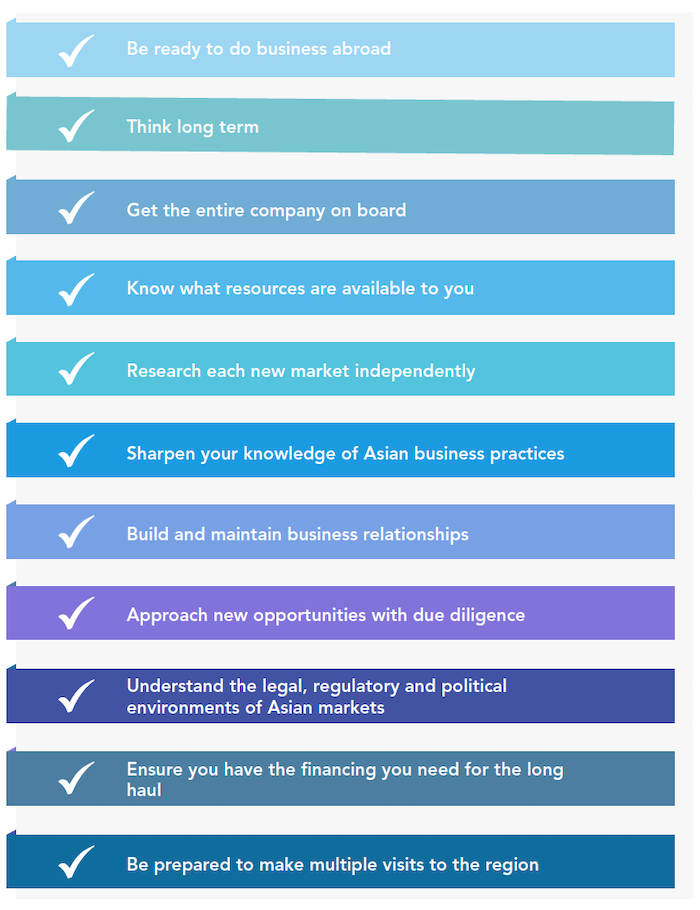
2: Exporting Preparedness Checklist
The Step-by-Step Guide to Exporting lists a number of important questions to ask yourself before going global:
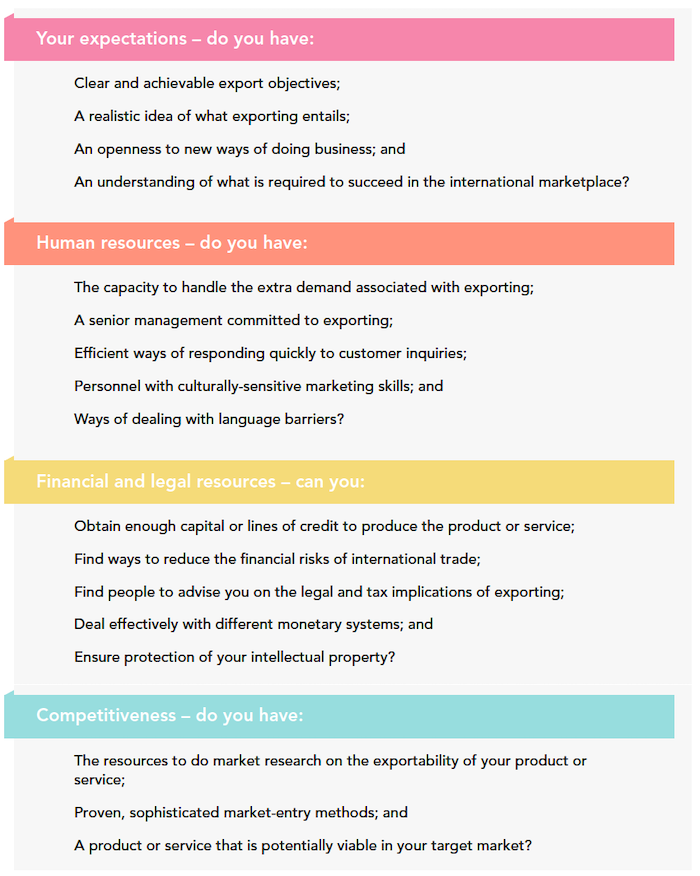
The Step-by-Step Guide to Exporting also lists factors to consider when evaluating your export potential:
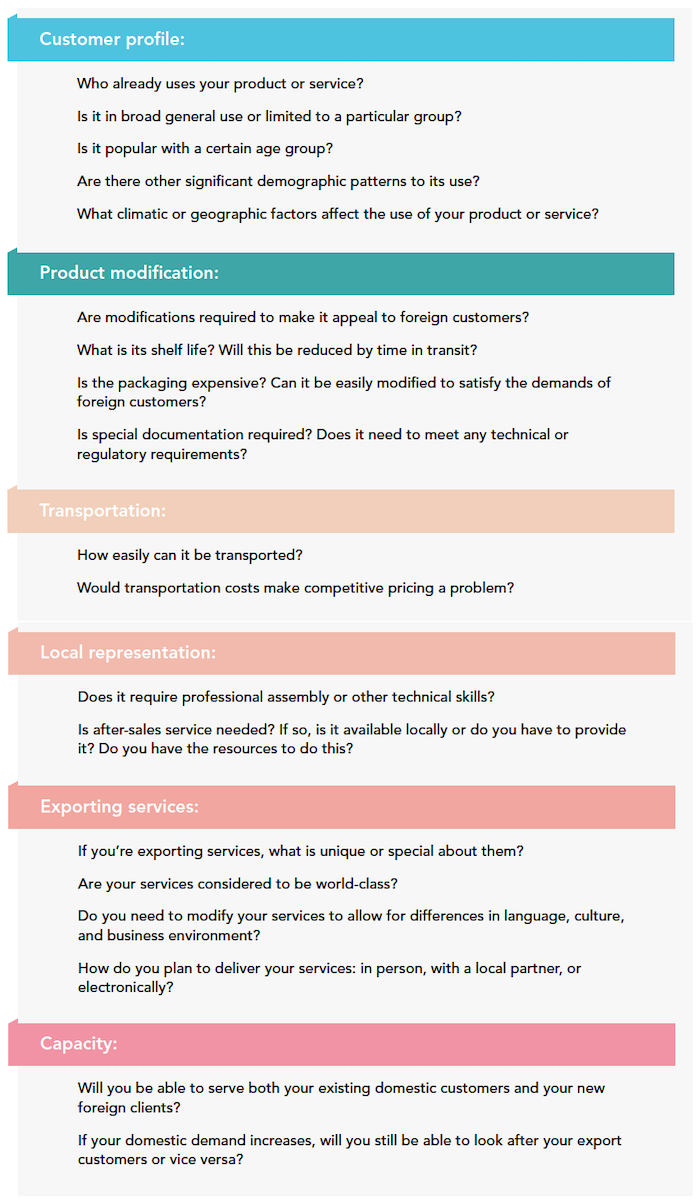
To help you prepare and navigate the complexities of international trade, take this quick Export quiz to see if you are ready and take a look at this free Step-by-Step Guide to Exporting.
A course to take to ensure you are well prepared for Asia Pacific engagement is the Trade Accelerator Program. TAP, as it is commonly called, was first offered by the Toronto Region Board of Trade in 2015 and is now offered nationwide. Contact an office in your area for more information and to register. The fees will be waived for Indigenous businesses.
3: In-Country Resources: Northeast Asia
The following provides links to various offices throughout Northeast Asia that can be contacted to provide information for planning, financing, and connecting with potential partners.
Trade Commissioner Service Offices
China Offices: Beijing, Chengdu, Chongqing, Guangzhou, Hangzhou, Hong Kong, Nanjing, Qingdao, Shanghai, Shenyang, Shenzhen, Tianjin, Wuhan, Xiamen, Xi’an
Additional resources can be found at the Trade Commissioner Services Canadian SME Gateway to China.
Japan Offices: Kitakyushu, Osaka, Sapporo, Tokyo, Nagoya
Export Development Canada
EDC China:
Chia Wan Liew, EDC Chief Representative
Tel.: (86-21) 3279-2832
Email: cliew@edc.ca
Alberta Trade Offices
China Offices: Beijing, Guangzhou, Hong Kong, Shanghai
BC Trade Offices
China Offices: Beijing, Guangzhou, Hong Kong, Shanghai
Ontario Trade Offices
China Offices: Beijing, Chongqing, Hong Kong, Shanghai
Quebec Trade Offices
China Offices: Qingdao, Shenzhen
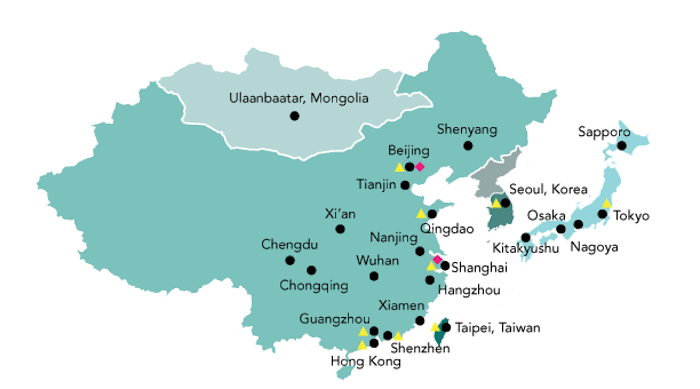
4: In-Country Resources: Southeast Asia
The section provides information for various offices throughout Southeast Asia that can be contacted to provide information for planning, financing, and connecting with potential partners.
Trade Commissioner Service Offices
Vietnam Offices: Hanoi, Ho Chi Minh City
Brunei, Indonesia, Malaysia, Singapore, Burma (Myanmar), Laos, Philippines, Thailand, Cambodia
Alberta Trade Office
BC Trade Offices
Philippines, Indonesia, Singapore
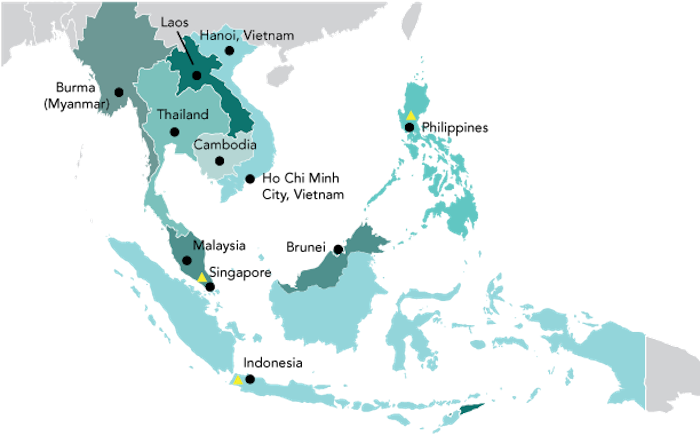
5: In-Country Resources: South Asia
This section provides information for various offices throughout South Asia that can be contacted to provide information for planning, financing, and connecting with potential partners.
Trade Commissioner Service Offices
India Offices: Ahmedabad, Chandigarh, Hyderabad, Mumbai, Bangalore, Chennai, Kolkata, New Delhi
Pakistan Offices: Islamabad, Karachi
Alberta Trade Office
BC Trade Offices
India Offices: Delhi, Chandigarh, Mumbai
Ontario Trade Offices
India Offices: Mumbai, New Delhi
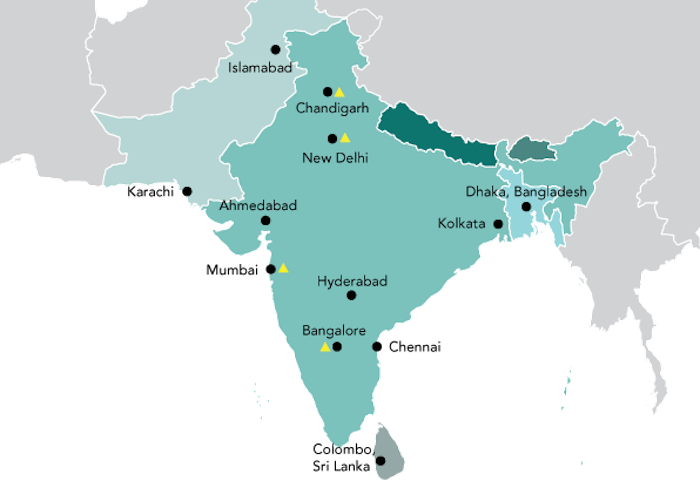
6: In-Country Resources: Oceania
This section provides information for various offices throughout the Pacific that can be contacted to provide information for planning, financing, and connecting with potential partners.
Trade Commissioner Service Offices
Australia Offices: Canberra, Sydney
New Zealand Offices: Auckland, Wellington
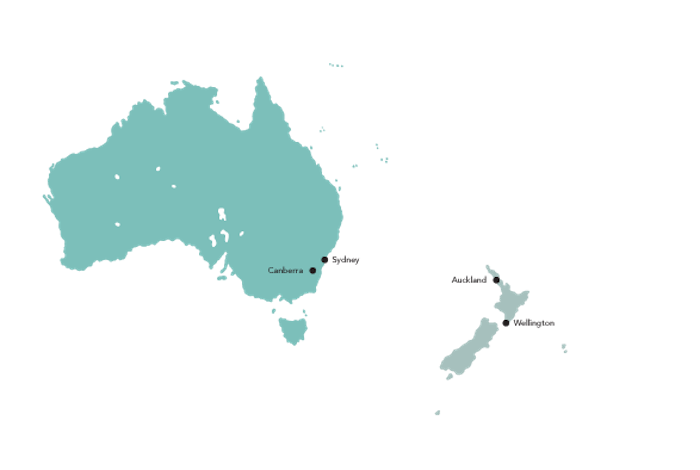
7: Provincial Support for Doing Business in Asia
In addition to federal government programming, provinces and territories also have services for supporting international business. Some provinces have their own trade offices in the region. Provinces with international trade offices are listed in numbers 3 to 6 of this section. Information for provincial domestic trade support is listed below.
Alberta Trade Support
Invest Alberta provides support for Alberta companies looking to grow internationally. Nine of the province’s 12 international offices are in Asia.
BC Trade Support
Trade and Invest British Columbia provides support for BC companies looking to grow internationally. They may have services for Asia Pacific regions.
Manitoba Trade Support
The World Trade Centre Winnipeg provides support for Manitoba companies looking to grow internationally. They may have services for Asia Pacific regions.
New Brunswick Trade Support
Opportunities New Brunswick (ONB) provides support for New Brunswick companies looking to grow internationally. They may have services for Asia Pacific regions.
Newfoundland and Labrador Trade Support
International Business Development (IBD) provides support for Newfoundland and Labrador companies looking to grow internationally. They have services for Asia Pacific regions.
Northwest Territories Trade Support
You may find trade support from the Northwest Territories Industry, Tourism, and Investment programs and services.
Nova Scotia Trade Support
Nova Scotia Business Inc. (nsbi) provides support for Nova Scotia companies looking to grow internationally. They may have services for Asia Pacific regions.
Nunavut Trade Support
The Nunavut Department of Economic Development and Transportation has various programs and resources that may provide support for Nunavut companies looking to grow internationally.
Ontario Trade Support
Invest in Ontario provides support for Ontario companies looking to grow internationally. They have services for Asia Pacific regions.
PEI Trade Support
Global Trade Services provides support for PEI companies looking to grow internationally. They have services for Asia Pacific regions.
Trade Team PEI provides support for PEI companies looking to grow internationally. They have services for Asia Pacific regions.
Quebec Trade Support
Quebec International provides support for Quebec companies looking to grow internationally. They have services for Asia Pacific regions.
Saskatchewan Trade Support
The Saskatchewan Trade and Export Partnership (STEP) provides support for Saskatchewan companies looking to grow internationally. They may have services for Asia Pacific regions.
Yukon Trade Support
You may find trade support from the Government of Yukon funding and support for business.
8: Relevant Canada–Asia Pacific Free Trade Agreements and Foreign Investment Promotion and Protection Agreements
FTAs in force
Comprehensive and Progressive Agreement for Trans-Pacific Partnership (CPTPP)
This agreement strengthens and diversifies trade and investment; creates new jobs; creates commercial opportunities with new free trade partners (Australia, Brunei, Japan, Malaysia, New Zealand, Singapore, and Vietnam) and existing partners (Chile, Mexico, and Peru); eliminates tariffs and non-tariff barriers for sectors such as agriculture, forestry, industrial machinery, heavy equipment, and services; includes labour and environment chapters; and increases investment protection, predictability, and transparency.
Canada–Korea Free Trade Agreement
The Canada-Korea FTA came into force January 1, 2015. This agreement provides increased market access, simplifies business such as through easier clearing of goods through customs, reduces non-tariff barriers, increases access for services and temporary entry, and provides a gateway to other Asian countries.
FIPAs in force
FIPA negotiations began in 1994 but froze until the completion of China’s accession to the World Trade Organization. Negotiations resumed in 2004 and the two governments signed the document in 2012. The treaty came into force on October 1, 2014.
Negotiations were concluded on May 23, 2015. The treaty came into force September 6, 2016.
The first round of negotiations took place in 2009. The Canada-Mongolia FIPA came into force on February 24, 2017.
This FIPA entered into force on November 13, 1996. In 2010, Canadian direct investment in the Philippines totalled C$761M.
This FIPA came into force September 24, 1998.
FTAs and FIPAs in discussion and negotiation
Negotiations of this FIPA were concluded in June 2007; the agreement was signed but has not been ratified. This FIPA is paving the way for discussions regarding the Canada–India Comprehensive Economic Partnership Agreement, which is now in negotiations.
The third and most recent round of negotiations of this FIPA were held May 28 and 29, 2012, in Ottawa.
The tenth round of the Canada-India Comprehensive Economic Partnership Agreement negotiations took place in August 2017, with agreement for more negotiations.
On September 22, 2016, Canada and China announced the launch of exploratory discussions for a possible Canada-China FTA. The most recent set of meetings took place from July 31 to August 4, 2017.
Exploratory discussions for potential negotiations of a bilateral FTA were launched in May 2015, and a meeting took place in July 2015. Now the exploratory discussions are focused on overall economic engagement with ASEAN member states.
In March 2013, Canada and Thailand announced the launch of exploratory discussions for potential negotiations of a bilateral free trade agreement. The exploratory discussions concluded in July 2015. Now the Canadian government is focused on exploratory discussions on overall economic engagement with ASEAN member states. [9]
9: Resources for Networking and Partnership Building in Canada and the Asia Pacific
The following resources may help with preparing for visits from Asia Pacific stakeholders and informing them about Indigenous cultures, histories, and business.
Seven Stages of Building Indigenous–Non-Indigenous Partnerships
Indigenous Works, an organization in Canada that was created to address the need to understand and improve Indigenous – non-Indigenous partnerships, created a seven-stage partnership model based on surveys with over 500 businesses and interviews. The seven stages are:
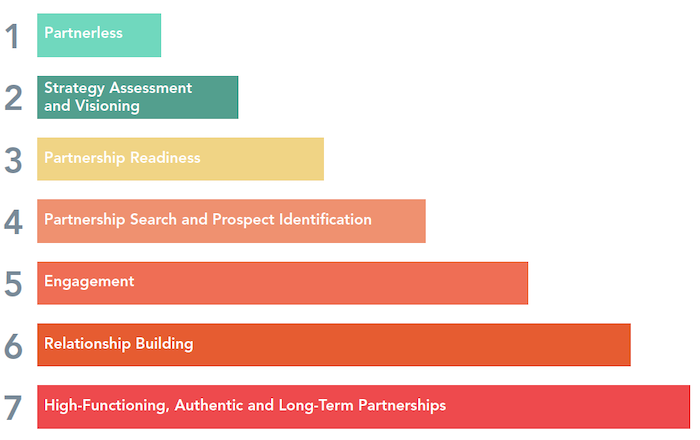
This partnership model provides characteristics of each stage and recommendations for successfully navigating from one stage to the next.
Resources for Engaging Indigenous Canada
Engagement is a two-way process. Just as Indigenous businesses must learn about each particular market, culture, and people of a particular place in Asia Pacific, it may be beneficial for potential Asian partners to learn more about Indigenous Canada. While there are no comprehensive resources or organizations dedicated to this, there are a number of resources that could be shared to help inform and prepare Asia Pacific stakeholders for engaging with Indigenous Canada. These include:
Japanese Translation Mandarin Chinese Translation Korean Translation
- BC (2014): Guide to Involving Proponents When Consulting First Nations;
- Association for Mineral Exploration BC (2015): Aboriginal Engagement Guidebook: A Practical and Principled Approach for Mineral Explorers;
- City of Vancouver (2014): First Peoples: A Guide for Newcomers;
- Alberta (2013): Aboriginal Peoples of Alberta: Yesterday, Today, and Tomorrow;
- Canadian Construction Association (2016): Indigenous Engagement Guide;
- Engaging Saskatoon Region Employers (2019): The Business Case for Reconciliation can provide reasons, lessons learned, best practices, and more for employing Indigenous peoples. This resource can be especially useful in resource projects or others where your partner may hire Indigenous workers; and
- Bob Joseph & Cynthia Joseph (2017): Working Effectively with Indigenous Peoples.
There is also a wide variety of consulting firms that do work on Indigenous–non-Indigenous relations that may be able to help with Asia Pacific stakeholders.
Networking Through Canada-based Indigenous Organizations
![]()
The following organizations may be beneficial to connect with and several hold regular events:
- The International Inter-Tribal Trade and Investment Organization (IITIO) seeks to support and enhance the implementation of the global flow and exchange of Indigenous goods, services, and investments. Global Indigenous business information and news is available at this website;
- The International Indigenous Trade Mission and Conference is held twice a year and can provide information and networking opportunities for Indigenous global business;
- The World Indigenous Business Forum is an annual forum that attracts Indigenous people from around the world to discuss global economic issues and provides information and networking opportunities for Indigenous global business;
- The Canadian Council for Aboriginal Business, a national organization with over 700 Indigenous and non-Indigenous members, offers networking opportunities, research on Aboriginal businesses in Canada, and resources geared toward helping Indigenous business succeed;
- Raven Events’ Advanced Business Match Indigenous runs trade and business matching events across the country with a current focus on the Prairies, West, East, Alberta, and Vancouver Lower Mainland;
- The Aboriginal Women’s Business Entrepreneurship Network provides support and assistance for Aboriginal women in business at all levels of business, including with specific programs and resources and an annual conference;
- The Inuit Women in Business Network provides support and assistance for Inuit women in business at all levels of business;
- Business Women in International Trade provides trade support and advice, from women-focused trade missions to advice and financing, for majority (51%+) women-owned and managed businesses;
- The Reservation Economic Summit is the largest Indigenous business conference in the United States and provides a large networking and business opportunity; and
- The NMSDC Conference and Business Opportunity Exchange, located in the United States, provides a large forum with the purpose of connecting organizations to minority (including Indigenous) suppliers for procurement and business opportunities.
Networking Through Canada-based Asian Business Associations and Trade Offices
![]()
• Canada China Business Council
• Canada Korea Business Association
• Canada-India Business Council
• Canada-Vietnam Trade Council
• Hong Kong-Canada Business Association
• Taiwan Chamber of Commerce in BC
Networking Through Canada-based Asian Business Associations and Trade Offices
![]()
Canadian Chambers of Commerce and Business Associations in Key Markets
• China, Hong Kong, India, Japan, Indonesia, Korea, Philippines, Singapore, Taiwan, Thailand, Vietnam
• Association of Southeast Asian Nations
• World Chamber Network
Consulates / Embassies and Trade Offices
Australia, China, India, Indonesia, Malaysia, Japan, Korea, Philippines, Mongolia, New Zealand, Singapore, Taipei, Thailand, Vietnam
Government of Canada
• Trade Commissioner Service: Events abroad and events in Canada
• Export Development Canada: Events
• Agriculture and Agri-Food Canada: Trade shows
Mentoring Support in Canada

• Futurpreneur Canada
• MentorshipBC
• Forum for Women Entrepreneurs Mentor Program
• Startup Canada
• Ontario Small Business Services: Indigenous entrepreneur guide to starting a business
• Innu Business Development Centre
10: Financing and Logistical Tools
A 2016 survey by the Canadian Council for Aboriginal Business reports that finding and then qualifying for financing are key obstacles for about half of Aboriginal businesses and that women probably find it more challenging to access financing than their male counterparts. Seven out of ten Aboriginal businesses do not have a formal business plan and cite not seeing the value of having one or not having the resources to develop one. This is noteworthy because having a formal business plan can provide a solid foundation for a company and is often a requirement for accessing financing.
As said by the CFO of Indigenous and Northern Affairs Canada:
I see two main challenges: community infrastructure and connectivity in First Nation communities and the persistent socio-economic gap between many First Nations and other Canadian communities. First Nations have entrepreneurial spirit the same as other Canadians, but were often not afforded the same resources and opportunities as other Canadians.
However, I am happy to say that these are all issues that are getting increasing attention and funding. My department is working with First Nation people and communities across Canada to support their aspirations to pursue economic development opportunities and wealth creation. There have also been substantial Government of Canada investments in infrastructure made in recent years in First Nation communities, and increased education funding to improve future opportunities for First Nation youth. – Paul Thoppil, CFO of Indigenous and Northern Affairs Canada [10]
The following links provide specific financing and logistics support for Indigenous peoples seeking to enter the global economy.
Indigenous Business Finance Support
- Aboriginal Financial Institutions (AFIs) are the primary Indigenous-owned financial supporters of Indigenous business. There are 59 AFIs located across every province and territory in Canada, and the National Aboriginal Capital Corporations Association (NACCA) website lists them by province or territory and provides a map indicating the location of each AFI. Fourteen of the AFIs, as shown on this website, also administer the Aboriginal Business and Entrepreneurship Development Fund provided by the Government of Canada to support Indigenous business development. These financial supports generally provide more support and favourable terms, such as lower interest rates, than other financial institutions;
- First Nations Financial Authority provides First Nations governments with investment options, capital planning advice, and long-term loans with favourable interest rates;
- Indigenous Tourism Association of Canada provides grants for Indigenous tourism companies, particularly those seeking international clients; and
- Joint Economic Development Initiative provides funding and programs for Indigenous economic development in New Brunswick.
Government of Canada Support
There are several government programs specifically for Indigenous business financing and support.
- Community Opportunity Readiness supports Indigenous communities seeking or pursuing economic opportunities, such as for associated feasibility studies, marketing, or legal fees;
- Entrepreneurship and Business Development Fund is an Indigenous business establishment and development funds specifically for the three territories;
- Lands and Economic Development Services Program provides funding for First Nations and Inuit communities to pursue economic development and address reserve land and environmental management;
- Northern Participant Funding Program helps Indigenous peoples and northerners effectively participate in impact assessment reviews for major infrastructure and resource extraction proposals;
- Aboriginal Business and Entrepreneurship Development is a federal Indigenous business development fund administered by 14 of the Indigenous owned Aboriginal Financial Institutions throughout Canada, which are themselves coordinated by NACCA;
- Indigenous Growth Fund (NACCA) will allow AFIs to provide more loans to Indigenous startups and Indigenous businesses;
- Funding for Indigenous Economic Development – Ontario provide funding for Indigenous business and economic development in Ontario;
- Indigenous Business Development Services provides funding for Indigenous business development in Manitoba; and,
- The Export Financing web page lists a wide variety of federal and provincial level funding programs.
The Trade Commissioner Service also offers various funding programs in support of exporting and innovation.
Export
CanExport is a federal program that provides financing for exploring foreign markets for exporters. Several business activities are eligible for financing, including target market visits and trade shows.
- CanExport – SMEs provides financial assistance to Canadian registered small and medium-sized enterprises to help them develop export opportunities for their product or service in new international markets. The AgriMarketing Program SMEs Component supporting international promotion and market development activities in the agriculture and agri-food sectors is now part of CanExport – SMEs;
- CanExport – Community Investments provides support for communities looking for foreign direct investment;
- CanExport – Associations allows Canadian national trade organizations to access up to $400,000 in annual funding to cover up to 75% of the cost for new or expanded international development activities; and,
- CanExport – Innovation allows Canadian innovators who aim to commercialize technology to access up to C$75,000 in funding to establish new R&D collaborations with foreign partners to co-develop, validate, or adapt their technologies for commercialization.
Innovate
- Canadian International Innovation Program supports collaborative industrial R&D projects with potential for commercialization between Canada and five countries (Brazil, China, India, Israel, and South Korea).
Export Development Canada Resources
Managing risks:
• Credit Insurance protects against nonpayment:
- EDC Select Credit Insurance will cover up to 90% of losses in case on nonpayment;
- Portfolio Credit Insurance will cover up to 90% of losses in case on nonpayment; and,
• Performance Security Insurance businesses can use this service if there is a concern that the customer will call a guarantee.
Securing financing:
• Buyer Financing helps provide a competitive financing package as part of a sales pitch to foreign customers;
• Direct Lending is financing to sell into markets outside Canada;
• Structured and Project Finance provides project financing for various international operations; and
• Purchase Order Financing covers up to 90% of purchase order financing and supports cash flow.
Growing working capital:
• Export Guarantee Program provides a guarantee to companies’ financial institutions, encouraging them to support foreign ventures;
• Account Performance Security Guarantee issues letters of guarantee without using your cash or capital and puts up a 100% guarantee to your bank;
• Foreign Exchange Facility Guarantee prevents having to use collateral for foreign exchange contracts, freeing up cash; and
• Surety Bond Insurance provides easier access to contract or performance bonds.
Additional Canadian Financing Options
• Business Development Bank of Canada provides financing options, including for SMEs. Businesses can apply online for financing options for a wide variety of projects;
• Canadian Commercial Corporation helps companies doing business abroad, especially those pursuing contracts with foreign governments;
• Investment Agriculture Foundation of British Columbia can assist BC agriculture and agri-food exporters; and,
• Futurpreneur Canada is a non-profit that provides financing and logistical support and mentorship specifically for Canadian youth (ages 18-39).
Canadian Banks with Dedicated Indigenous Banking
• BDC Indigenous Entrepreneur Programs and Resources
• RBC Aboriginal Banking Programs and Services
• TD Indigenous Banking
• BMO Indigenous Banking
• Scotiabank Services for Aboriginal Peoples
• CIBC Indigenous Banking
• Vancity Indigenous Investments (focus on BC)
• Me-Dian Credit Union (focus on Manitoba)
• National Aboriginal Capital Corporations Association (NACCA), a network of Aboriginal Financial Institutions throughout Canada.
• First Nations Bank of Canada
• Raven Indigenous Impact Fund
• Peace Hills Trust
International Financial Institutions
• International financial institutions have large social and economic development programs. They can play an important role in financing and supporting Indigenous businesses who work with emerging economies, including assistance with funding, advising, and establishing development projects. International financial institutions include the World Bank, which Canada is a partner with, and the regional development banks listed below. Canadian membership with these banks provides access to procurement contract opportunities through projects funded by the banks. To learn about such procurement opportunities, contact Canada’s Offices of Liaison with International Financial Institutions (OLIFI) at the banks listed below.
World Bank (and Inter-American Development Bank)
OLIFI Washington
Ms. Carolyn Cudmore
Trade Commissioner
Tel: (202) 448-6416
Carolyn.Cudmore@international.gc.ca
Ms. Julie Mann
Trade Commissioner Assistant
Tel: (202) 682-7788
Julie.Mann@international.gc.ca
Asian Infrastructure Investment Bank
OLIFI Beijing
Ms. Lilian Zhou
Trade Commissioner (Liaison with the AIIB)
Tel: (86-10) 5139-4115
Lili.Zhou@international.gc.ca
Asian Development Bank
OLIFI Manila
Mrs. Meng Lulu LeBlanc
Trade Commissioner
Tel: (011-63-2) 857-9099
Menglulu.Leblanc@international.gc.ca
Ms. Lina Pulian
Trade Program Assistant
Tel: (011-63-2) 857-9131
lina.pulian@international.gc.ca
11: Industry and Logistical Information for a Successful Asia Pacific Business Strategy
- To inform your Asia Pacific business strategy, find information on Canadian industries here. APF Canada provides industry information with these publications, the Investment Monitor tool has key investment information in several industries between Canada and the Asia Pacific, and the APEC MSMEs website has similar information. You can purchase access to tools like IBIS World and Frost and Sullivan that provide comprehensive industry information, and Mint Global that provides company data, which may be available for free if you are a member of an academic institution;
- You can find access to US and Canadian suppliers, manufacturers, and distributers at ThomasNet and international suppliers and traders of all types of products and services at Wand;
- Country information can help you to understand the trade and investment risk of different countries and sectors based on measurements like political stability, economic data, and cultural trends. Country information can be found from free services such as Export Development Canada (EDC), the EDC Global Export Forecast, and the Trade Commissioner Service Country and sector information for international business. More information is available from CountryWatch (paid), Co-face (free), and more in depth information can be found at the World Bank e-Library and the OECD iLibrary (paid and free options);
- The Port of Vancouver’s Moving Cargo and Terminals and Facilities resources can help you with the logistics of getting your products to Asia. Other ports such as the Ports of Halifax, Quebec, and Prince Rupert also have informative websites;
- The Canada Business Network can also help with logistics and provides links to other organizations that offer logistics information; and
- Here are some links to information on different industries in various Asian countries:
China, Korea, Southeast Asia, India, Japan, Taiwan
Harmonized System (HS) Codes
All governments use a system to categorize the imports and exports of their country. Most of the world uses the Harmonized Commodity and Coding System, also known as Harmonized System Codes. You may have to find the HS code if you are seeking import or export information. All goods are assigned a six-digit classification code, where the first two digits refer to the product category, and the next four to six digits refer to different subcategories. Different countries can then add digits, up to 10 total, for more specific products. For example, using the Canada Post HS Code tool, if you put in Singapore as a destination and lentils as your product, the tool will ask you a few questions and then display 0713.40 as the HS code associated with dried and shelled lentils. The HS code is used when shipping products and for other trade information. You can put that code into Canada’s Tariff Finder, which has tariff information for countries with which Canada has a free trade agreement. You can also use the Tariff Finder itself to find which tariffs (if any) apply to the product you are exporting or importing. Otherwise, you can use Canada’s tariff information by country website, which has more countries.
12: Dealing with Asian Governments
Dealing with different governments and foreign businesses can be difficult. This section provides information on how to do so.
Protecting Your Intellectual Property (IP) and Traditional Knowledge (TK)
See IP Beyond Our Borders, Intellectual Property for Exporting Businesses, and Protecting your Intellectual Property Rights in China for information on protecting your IP. In addition to typical business IP, traditional knowledge is important to Indigenous peoples. TK provides valuable social and economic contributions and should be protected just as well as IP. Examples of TK include Indigenous peoples’ understanding of their local ecosystem, such as migration patterns; knowledge of how to make artwork or tools; and cultural materials like songs or symbols. Essentially, Indigenous peoples have some rights over what they know, have known, or will know, just like a technology company might know how to produce a certain product and have the right to use that knowledge and have it protected. TK is often crucial for Indigenous peoples’ subsistence and survival and may be crucial for Indigenous businesses to protect in global markets because it is a possible competitive advantage (e.g. authentic Indigenous products and/or services), and because there is often a sacredness of TK or cultural expression that has been provided from ancestors and passed on through generations, and is to be protected for future generations. For more information, see the World Intellectual Property Rights guide, Protect and Promote Your Culture – A Practical Guide to Intellectual Property for Indigenous Peoples and Local Communities.
Governments and Business Law
The following guides provide information on the ease of doing business and business law:
Australia, Hong Kong, India, Indonesia, Japan, Korea, Mongolia, New Zealand, Philippines, Singapore, Taiwan, Thailand, Vietnam
Risk Assessment
Economic Development Canada provides the Country Risk Quarterly, where you can learn about the risk of doing business in different countries, and Managing Risk: A guide for exporters, where you can learn about managing risk.
Benefiting from Trade and Investment Agreements
Trade and investment agreement information relevant to different Asia Pacific countries is provided by the Government of Canada.
13: Asia Cultural Guides, Basic Phrases, and Additional Government of Canada Resources
These resources can help with cross-cultural business considerations to help you prepare before going to Asia and to prepare for visits from Asian stakeholders.
Asia Pacific News
Asia Watch is a free subscription offered by APF Canada that provides the latest analysis of news, trends, and happenings in the Asia Pacific three times a week.
Cultural Guides
China, Hong Kong, India, Indonesia, Japan, Korea, Mongolia, Philippines, Singapore, Taiwan, Thailand, Vietnam
Basic Phrases
China (Mandarin), Hong Kong (Cantonese), India, Indonesia, Japan, Korea, Mongolia, Philippines, Taiwan (Mandarin), Thailand, Vietnam
Canadian Post-Secondary Institutions with Asia Pacific Related Centres
- David Lam Centre at Simon Fraser University (BC);
- Centre for East Asian Research at McGill University (Quebec);
- York Centre for Asian Research at York University (Ontario);
- Asian Institute at Munk School of Global Affairs at University of Toronto (Ontario);
- Institute of Asian Research at University of BC (BC);
- China Institute at University of Alberta (Alberta);
- Asian Studies Centre at University of Manitoba (Manitoba); and
- Centre for Asia-Pacific Initiatives at University of Victoria (BC).
Government of Canada Country-Specific Resources
China, India, Indonesia, Japan, Korea, Mongolia, Philippines, Singapore, Thailand, Vietnam
14: Current Indigenous Economic Development Practices
Practices and Approaches to Indigenous Economic and Business Development
The Public Policy Forum’s report Realizing The Potential: Global Perspectives on Indigenous Economic Development summarizes good practices of Indigenous economic development from 11 Canadian and global case studies:
Governance
• Establish relationships as early as possible
• Separate politics and business
• Develop and establish good governance arrangements
Broader Economic Impacts
• Make financing accessible and tailored to Indigenous entrepreneurship
• Establish joint ventures to help build capacity
• Leverage partnerships with other communities
Community Engagement
• Invest in diversified training and education programs
• Create pathways from school to jobs
• Develop long-term community plans, including a strategy for royalties
This is the report’s summary of principles for successful development:
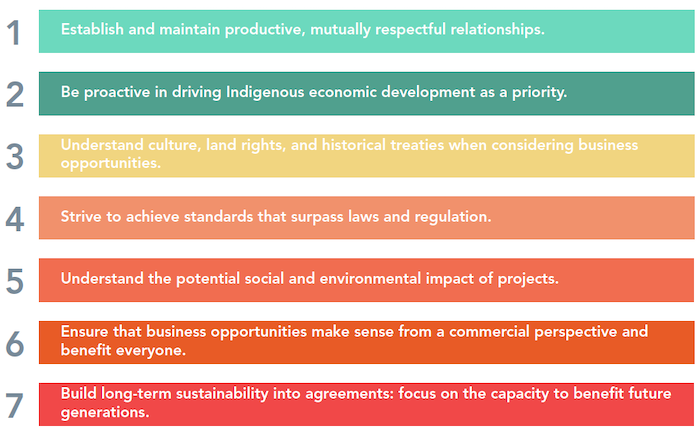
The Indigenous Approach to Economic Development
According to Anderson and Kayseas, two Canadian academics who have done significant work on Indigenous economic development:
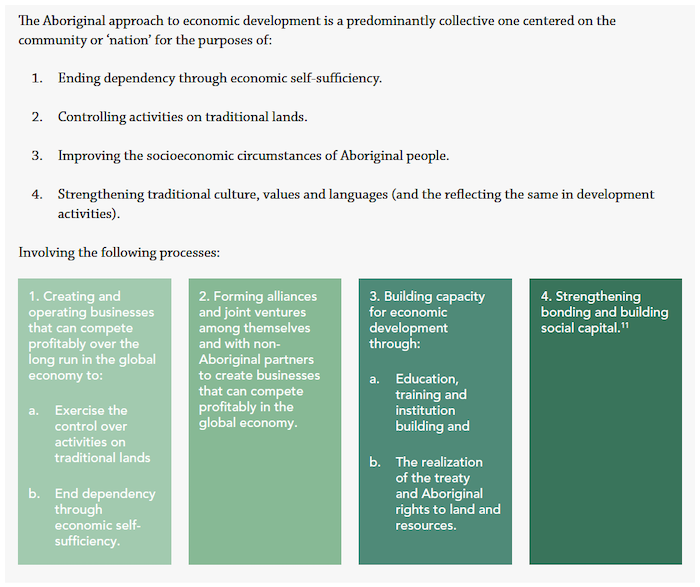 [11]
[11]
Additional Indigenous Business Development Tips
1. Any conversation on Indigenous entrepreneurship may benefit from including community perspectives and social objectives. Entrepreneurship can be a “multi-objective” endeavour, where achieving both social and economic objectives is possible. The lines between the two are often blurred in the Indigenous community. What makes a group Indigenous is often, though not always, conducive to a more communal approach to entrepreneurship. Connecting to the global economy is seen by many as the key to Indigenous development, and development in turn is seen as a key component of reconciliation. Entrepreneurship can be the catalyst for this action. Entrepreneurship is conducted and should be conceived of not only at the individual level, but also the communal level, for the Indigenous community where development corporations and co-operation are prominent. [12] “The establishment of a successful Indigenous venture [may] require[s] dual leadership: a cultural authority and a practical ‘hard driver.’ … [C]ultural authority provides reassurance to every band member that these enterprises are compatible with the aspirations and traditions of the band.” Someone is also required to “translate intentions to actions.” [13]
2. Consider how Indigenous governments and development corporations act as mediating structures. Development corporations support bridging to external economies, and governments facilitate a positive social environment, reducing conflict and increasing bonding within the community. Together, these structures can enable communities to opt in to the global economy. [14]
3. Consider differences and similarities between Indigenous economic development and classic economic development. Indigenous economic development includes Indigenous values and social, environmental, historical, and cultural considerations, whereas classic economic development focuses on land, labour, and capital. These differences provide both challenges and opportunities for entering Asia Pacific markets.
4. Consider pros and cons of starting your business on reserve. Starting a business as a sole proprietorship on reserve may have tax benefits, but could limit future growth by reduced access to formal and informal equity capital. [15]
5. Plan for business leadership succession. “The durability of a successful Indigenous venture is potentially more vulnerable to generational change than is mainstream enterprise.” [16]
6. Remember that starting a business is just the start and that change and growth may take time. “For an Indigenous venture, change [may] be even harder than creation.” For example, this is often the case in situations when the correct business decision is to cease an enterprise but there is significant pressure to maintain jobs or a positive image within the community. [17] The following figure lists obstacles to growth for exporting and non-exporting Indigenous businesses.

Source: Audrey Bélanger Baur (2019), Indigenous-Owned Exporting Small and Medium Enterprises in Canada, Global Affairs Canada & Canadian Council for Aboriginal Business, p. 33
7. Having higher levels of education, more experience, and a business plan will bolster export success. The 2019 GAC-CCAB report found that a university or post-graduate education increases the proportion of exporters to non-exporters, that SME owners with more than 10 years of management experience are more likely to export and those with under 5 years of experience are much less likely to export, and that having a business plan makes it almost 10% more likely that an Indigenous enterprise will export.
15: Engagement Strategies of Previous Indigenous-Asia Stakeholders and Indigenous Global Business Examples
The following bulleted lists provide specific recommended actions developed by an Indigenous organization seeking to increase engagement with Asia.
BC First Nations Energy and Mining Council China Strategy Recommended Actions
- First Nations Capacity Building – partnering with provincial and federal governments and foreign universities to improve capacity and engagement ability;
- Promote opportunities for engagement with China interests – annual missions to and from China, developing formal and informal relationships with Asian organizations and associations in Canada (such as the Asia Pacific Foundation of Canada);
- Establish a China Desk to assist First Nations to respond to and develop business opportunities – will help access markets, promote products, understand opportunities, and connect with investors;
- Develop best practices for engagement – to promote adequate consultation and collaboration, advice for negotiating mining agreements;
- Expand market opportunities for First Nations in China – Exploring specific opportunities in forestry and tourism, seeking federal funding support;
- Approach the provincial and federal governments to discuss and develop mutual benefits/opportunities – promoting specific working groups and initiatives; and
- Create a unified message – branding to ensure inclusion of First Nations peoples, ensure needs and desires are heard, with specific plans to communicate to various levels of business and government in Canada and China.
BC First Nations Energy and Mining Council Japan Strategy Recommended Actions
- Conduct a First Nations trade mission to Japan;
- Formalize a cultural exchange with the Ainu people;
- Develop programs to foster Asia competence in First Nations youth;
- Engage in dialogue with Japanese counterparts to create understanding of First Nations; practices, traditions, and norms; and
- Build consensus with stakeholders and develop and adopt a First Nations strategy on Japan.
Indigenous Global Business Examples
In addition to a variety of new services, the Trade Commissioner Service has collected a variety of Indigenous exporting and importing success stories on its Spotlight on Inclusive Trade – Indigenous Business web page. The TCS highlights the importance of free trade agreements, particularly the Canada-European Union Comprehensive Economic and Trade Agreement (CETA), as an important factor for all the examples. Briefly, they include:
- Glooscap Ventures, a Glooscap First Nation community-owned group of businesses, imports Greek feta cheese for use in other products through its partnership with the Greek cheesemaker Ilia Gourmet. Their partnership is based on shared social values. This story highlights how partnerships can provide unique opportunities and can be strong when they are based on shared values;
- Arctic UAV is an Indigenous-owned, Iqaluit, Nunavut, based business that provides Unmanned Aerial Vehicle services such as photography and videography. They recently went global by opening an office in Greenland, which provides them easier access and exporting to other European markets. This example shows that establishing a physical presence, when done strategically, can ease the process of accessing new markets and is often a smart first step when globalizing;
- Little Miss Gourmet Products Inc. is owned by Indigenous businesswoman Ellen Melcosky of Esketemc First Nation. She discussed how the TCS helped her begin exporting. This story highlights the importance of the TCS. Ellen recommends even reaching out and letting them know you may be interested in exporting; and,
- Okwaho Equal Source is a global consultancy with offices in Canada and Australia and clients around the world. It is focused on Indigenous-owned enterprises and social, economic, and environmental impact. It is 100% owned by Anishinaabe, Kanien’kehá:ka, and Māori Indigenous peoples. This story highlights the possibility of partnering with Indigenous nations around the world with similar goals. There are Indigenous enterprises around the world that have the same needs and desires, particularly the large need for business development activities from the local to the global level.
16: Examples of Shared Indigenous-Asian History, Culture, and Values
Cross-cultural aspects of global business can improve or decrease the quality of partnerships and chance of success in business. It is, therefore, important to understand the cultures, histories, interests, and values of people (non-Indigenous and Indigenous) and markets of the Asia Pacific, of which there is great diversity.
Cultural Dimensions
There is a large amount of cultural diversity among the non-Indigenous and Indigenous people in the Asia Pacific. At a broad level, there are some similarities, such as the importance of relationships, and values such as community, long-term thinking, and patience, in business and life. Business dealings that address cultural similarities can quickly establish deeper relationships, a feat that is otherwise difficult in the fast-paced world of business.
Indigenous Works states some characteristics of traditional Indigenous culture as follows:

Upon a review of values presented in Aboriginal communities across North America, Ojibway-Anishinaabe elder Jim Dumont asserted that there are seven primary traditional values: kindness, honesty, sharing, strength, bravery, wisdom, and humility. [18]
Cultural dimensions, known as Hofstede’s cultural dimensions, have commonly been used in international business literature, and are often used to compare the cultural orientations of different countries. Using Hofstede’s dimensions, Indigenous cultures across eight countries have been generalized to have high collectivism/low individualism (meaning Indigenous peoples are more likely to work together and less likely to value individual achievements), low power distance (meaning Indigenous peoples are less likely to have a hierarchical organization, where decision-making and power are clearly given more to certain people and less to others), low uncertainty avoidance (meaning Indigenous peoples are more likely to embrace uncertainty), and high femininity/low masculinity. [19] Figure 8 compares the cultural orientations of some Asia Pacific countries for reference. Several countries have cultural similarities to generalized Indigenous people’s cultures, but it should be noted that these scores don’t represent Indigenous populations, and the Indigenous cultural dimensions used above are based on eight countries.
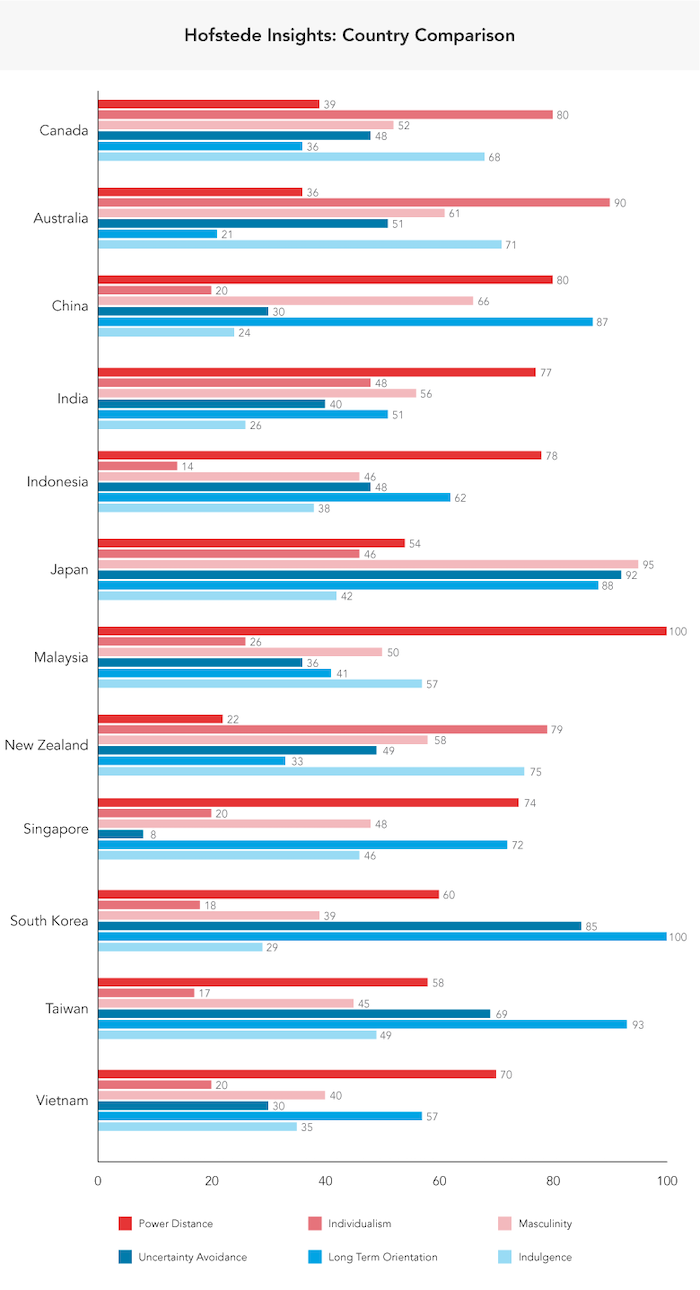
Source: Hofstede Insights
Shared Canada–Asia Pacific Indigenous Experiences
The following historical accounts provide information on how Indigenous peoples have a long history of shared experiences, culture, and hardships, that can provide a base for meaningful engagement in business.
Historical Colonial Patterns
Details and timelines differ, but colonial experiences were often similar across Indigenous nations in Canada and the Asia Pacific, including Japan, Taiwan, New Zealand, and Australia. Similarities include systemic discrimination and oppression, forced relocation, assimilation, the separation of children through work programs or residential schools, and the resulting increase in negative outcomes such as poverty and incarceration and decrease in positive outcomes such as higher educational attainment or healthy lifestyles. These shared historical injustices led to a shared presence in global movements for Indigenous rights, leading to national and international recognition of rights, for example through UNDRIP. This led to the now-shared presence in the global movement for Indigenous business, for example with many states and Indigenous peoples collaborating to support Indigenous business, including through state Indigenous business strategies, trade missions, and articles in trade agreements.
Asia Pacific Cultural Affinities
• The Pacific Peoples Partnership works to support collaboration on issues of Indigenous peoples in the South Pacific and Canada. People around the Pacific share many similar cultures and concerns.
• The Asia Indigenous Peoples Pact is a regional organization focused on promoting rights and issues of interest and relevance to Indigenous peoples in the region.
• The Asia Indigenous Women’s Network is a regional organization that promotes the rights and issues of interest and relevance to Indigenous women in the region.
• The Asia Young Indigenous Peoples Network is a regional organization that promotes the rights and issues of interest and relevance to Indigenous youth in the region, particularly culture, selfdetermination, the environment, and human rights.
Current Canadian Indigenous–Asia Pacific Indigenous Relations
Māori-Canadian Indigenous Connections
• Three Māori representatives participated in a cultural exchange with the Inuit in Iqaluit in early 2019, with hopes of furthering cultural ties for the purpose of learning from each other and inspiring confidence to participate in their traditional cultures. There are many examples of such cultural exchanges.
• The University of Northern British Columbia provides a cross-cultural Indigenous knowledge exchange with the Māori, and the University of Otago provides similar exchanges for Māori. Māori from the University of Canterbury visited members of the First Nations Tax Commission and Tulo Centre of Indigenous Economics in 2016 to generate relationships and ideas for tax planning and economic development.
• A Canadian Indigenous business delegate travelled to New Zealand and met with Māori people in 2018 during the World Indigenous Business Forum, and Canadian Indigenous and Māori delegates travelled together and had meetings on a trade mission to China. The Trade Commissioner Service of Canada has been actively working on Indigenous-Māori business opportunities in New Zealand.
Taiwan Aborigine-Canadian Indigenous Connections
• In June 2015, a 10-person delegation from the Taiwan Council of Indigenous Peoples met with Indigenous organizations around the country, including the First Nations Tax Commission. The delegation aimed to learn about economic development and financial practices on reserve.
• A Memorandum of Understanding was signed between the Canadian Trade Office in Taipei and the Taiwan Council of Indigenous Peoples on Indigenous co-operation in 1998, and renewed in 2008. Such co-operation includes culture, health, education, policy, and economic development.
• Taiwan held an international Indigenous economy forum in 2018 that included, among many other countries, Canadian delegates.
Japan Ainu-Canadian Indigenous
• Delegates of the Métis Nation visited several Ainu organizations and discussed the Métis people in Japan during 2013.
• Japan and Canada have many “twin” cities, established to promote relations between the two countries. These twin cities often have Indigenous cultural components including exchanges and art collaborations of the Ainu and Canadian Indigenous peoples.
• There have been various cultural exchanges with the Ainu, including with the Tlingit people of the Yukon and BC, Simon Fraser University, and some through the University of Manitoba.
Australian Aborigine-Canadian Indigenous Connections
• There is an Indigenous-Indigenous exchange program offered by the University of Victoria and the Wollotuka Institute in Australia, and the University of British Columbia provides the Indigenous-Indigenous Australia Leadership Program exchange with St. Catherine’s Residential University College. There are other examples of cultural exchanges with Thompson Rivers University and in art.
• Delegates from Canada and Australia met at the 2015 World Indigenous Business Forum.
Indigenous–Non-Indigenous Asia Pacific Relations in Canada
• Chinese visits to Canada were first recorded in 1788 to Nootka Sound, BC, but there exists evidence of Chinese trade with Indigenous peoples predating that time by centuries. In 1858, Chinese immigrants arrived in large numbers in Vancouver, where they faced dangerous working conditions on the Canadian Pacific Railroad and treatment as second-class residents. This status was reinforced by the Canadian government’s Chinese Immigrant Act of 1885. The Act enforced ever-increasing head taxes on the Chinese people. The updated 1923 Act entirely banned Chinese immigration, with some special circumstance exceptions, giving it the nickname of the Chinese Exclusion Act. Parallels have been drawn between the act and treatment of Chinese people in Canada with the Indian Act of 1876 and treatment of Indigenous peoples. [20] The Canadian government issued a formal apology along with some symbolic payments to surviving head-tax payers in 2006.
• Japanese immigrants have had similar experiences in Canada, including in Steveston, BC, and along the BC coast. Japanese people likely met First Nations people for the first time in 1877 when the first known Japanese migrant came to Canada. Relations moved from hostile to friendly as Japanese and Indigenous peoples recognized their shard discriminatory treatment. The prominent fishing industry along the Pacific coast that employed many First Nations people soon employed many Japanese rather than First Nations people. The Canadian government attempted to limit the number of Japanese immigrants. Japanese people held many jobs previously held by First Nations people, such as in the town of Steveston that had a large canning industry. During the Second World War, the Canadian government interned 22,000 Japanese Canadians and stripped them of their belongings and property.
After the eviction and internment of Japanese Canadians by the Government of Canada during the Second World War, greater understanding developed between the two populations. An important symbol of this is the Nishga Girl, a fishing boat built in 1967 by the Japanese-Canadian boat builder Judo Tasaka and given to the Nyce family of the Nisga’a. Nishga Girl symbolizes the thousands of fishing boats that were confiscated by the Canadian government from Japanese-Canadian fishermen during the internment period. The Nyce family had taught Tasaka how to build boats, allowing his family to become financially independent again. [21]
After the Second World War, First Nations people began advocating for Japanese Canadian redress, including an apology and compensation, which was eventually achieved in a 1988 agreement with the Canadian government.
• In Grassy Narrows, Ontario, an Indigenous community began suffering from mercury poisoning, a debilitating and lethal disease, around 1970. After initial research, Canadians paid little attention to the community’s experiences despite ongoing effects. A Japanese research team, that first arrived in
the community in 1975 has continued their research and outreach to the present. Over 100 people died of mercury poising in Minamata, Japan, during the 1950s. One of the Japanese scientists who arrived in 1975 made the first diagnosis of human effects, years after Canadians were aware of the issue, after hearing about a “mini-Minamata” from a Japanese photographer. He made over 100 diagnoses and identified dozens more suspected cases of poisoning. Canada has still not recognized any Minamata disease cases. Almost five decades later, the Japanese research team continues to use their experience to help Indigenous Canadians and advance our understanding of industrial affects on our food chain.
• Similarities have been drawn between “throat games” of the Ainu (an Indigenous people of Japan) and the Inuit, leading to a hypothesis that there was cultural diffusion from the Ainu of Northeast Asia to the Inuit of North America. [22]
• In the mid 20th century, the Inuit people of Canada, specifically in Cape Dorset, adopted the Japanese printmaking style. The style has had a significant impact on Inuit art.
Indigenous–Non-Indigenous Asia Pacific Relations in Asia
• The BCFNEMC has highlighted the cultural affinity between First Nations people and Chinese people using the example of cultural exchanges, such as the gifting of a totem pole after the 2008 Wenchuan earthquake for the lives lost and the Four Host First Nations cultural exchange during the Beijing Olympics. They also emphasize relationships built from historical discrimination and oppression by the BC and Canadian government, mutual support, respect, and shared values such as traditions and respecting elders.
• Government, business, and academic relations in China have been established by Grand Chief Edward John and the BCFNEMC. This includes interaction with the China Association for Intercultural Communication at Beijing Foreign Studies University, the sixth annual Canada-China Energy and Environment Forum, and meetings with Canada’s ambassador to the People’s Republic of China, Consul General of China to Canada in Vancouver Liang Shugen, Ambassador of China to Canada Zhang Junsai, Chinese banks, and mining and forestry companies.
• The Yinka Dene Alliance, consisting of five First Nations from northern B.C., sent a letter directly to Chinese President Hu Jintao in February 2012 in an attempt to create their own political connections, with the aim of preserving their lands from oil pipeline development without their involvement. The letter raised Indigenous issues including resistance to the northern gateway pipeline, in an attempt to add the issue to the agenda of a meeting between the Chinese leader and the Canadian Prime Minister shortly thereafter. [23] The alliance has also directly reached out to governments in Japan, South Korea, and the United States and members of the European Parliament to raise issues of concern.
• The Ainu, an Indigenous people of Japan, also share a similar history with Indigenous peoples in Canada. Policies as far back as the 1800s aimed to assimilate the Ainu people and turn them into Japanese style farmers. Like the Indigenous peoples of Canada, they had no legal recognition as an Indigenous people, were stripped of their cultural and societal elements, were nationally controlled, and only in 2008 did the national government officially recognize the Ainu as an Indigenous people. Beyond support for traditional cultural revitalization and tourism (e.g. 1997 Ainu Cultural Promotion Protection Act, 2019 Ainu Promotion Act), Canadian-style reconciliation remains a long way off.
17: Trends of Indigenous Participation in Exporting Industries
The figures in this section show trends in Indigenous participation in exporting and industries from a 2019 GAC-CCAB joint study that may help with understanding where current opportunities exist and what Indigenous self-employed entrepreneurs and SMEs are more likely to export.
The study found that the percentage of Indigenous-owed SMEs that export (24.4%) is higher than the national average (11.8%). While the report notes caveats about the accuracy of the numbers due to the small and select sample size, the numbers are still worth noting.

Source: Audrey Bélanger Baur (2019), Indigenous-Owned Exporting Small and Medium Enterprises in Canada, Global Affairs Canada & Canadian Council for Aboriginal Business, p. 18
Figure 10 shows in which industries self-employed Indigenous entrepreneurs operate.

Source: Audrey Bélanger Baur (2019), Indigenous-Owned Exporting Small and Medium Enterprises in Canada, Global Affairs Canada & Canadian Council for Aboriginal Business, p. 12
Figure 11 details the Indigenous SME market destination by sales by Indigenous identity.

Source: Audrey Bélanger Baur (2019), Indigenous-Owned Exporting Small and Medium Enterprises in Canada, Global Affairs Canada & Canadian Council for Aboriginal Business, p. 19
Figure 12 shows the industries (according to North American Industry Classification codes) that Indigenous SMEs operate in, the percentage of companies that are exporters and non-exporters, and the propensity of Indigenous SMEs in each of the industries to export. The exporter and non-exporter columns show the percentage of all Indigenous businesses that are in that industry and do or don’t export (i.e. out of all Indigenous enterprises, 3.9% are in construction and export, 36% are in construction and don’t export), and the export propensity column shows the percentage of all Indigenous enterprises in that industry that export (i.e. 3.4% of construction enterprises export). This figure shows the industries with the highest propensity to export are:
- Consulting (83.8%);
- Arts, entertainment, and recreation (69%);
- Accommodation and food services (57.5%);
- Manufacturing (50.1%);
- Real estate and rental and leasing (49.3%); and
- Retail trade (31.4%).

Source: Audrey Bélanger Baur (2019), Indigenous-Owned Exporting Small and Medium Enterprises in Canada, Global Affairs Canada & Canadian Council for Aboriginal Business, p. 22
As Indigenous businesses develop, counter to Canadian SMEs and typical international trade theory, they become less likely to export. This is due to many small (20-99 employee) enterprises operating in construction and natural resource extraction, which are not prone to exporting, and micro enterprises often being located on reserve, where market diversification is a necessity. [24]

Source: Audrey Bélanger Baur (2019), Indigenous-Owned Exporting Small and Medium Enterprises in Canada, Global Affairs Canada & Canadian Council for Aboriginal Business, p. 20
If you have access to certain products (e.g. fishing in the Atlantic, the resource sectors in Western Canada) or services (e.g. greater access to technology workers in larger cities) and are in an industry with a high propensity to export, it may be easier and more profitable to export. For exporters, according to a CCAB report, “Nearly one third are concentrated in Ontario (31.5 percent), over a fifth are located in British Columbia (22.8 percent), approximately one eight are in Quebec (12.5 percent) and Alberta (12.3 percent) respectively, and the remainder are distributed across the Atlantic provinces (7.9 percent), Saskatchewan (6.1 percent), Manitoba (4.9 percent) and the Territories (1.8 percent).” [25]
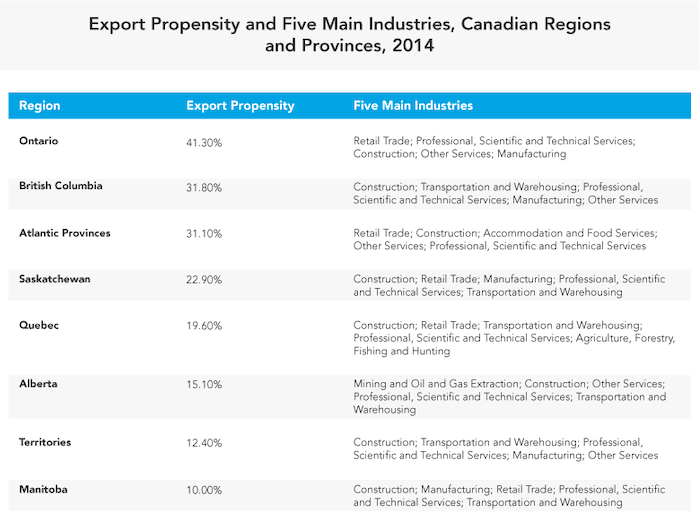
Source: Audrey Bélanger Baur (2019), Indigenous-Owned Exporting Small and Medium Enterprises in Canada, Global Affairs Canada & Canadian Council for Aboriginal Business, p. 25
Endnotes
[1] Groenfeldt, D. 2003. The future of indigenous values: cultural relativism in the face of economic development. Futures. 35: 917-929.
[2] The USMCA has several sections that promote Indigenous businesses; for example, Indigenous handicrafts are eligible to be duty free.
[3] Census. National Household. 2006, 2011, 2016.
[4] Norris, Dakota. 2019. Finding common ground: Engaging Indigenous Canadian youth with Asia. APF Canada; Global Affairs Canada. 2018.
Indigenous trade mission to New Zealand; and WIBF. 2019. The 2019 World Indigenous Business Forum.
[5] Dicken, Peter. 1992. International production in a volatile regulatory environment: the influence of national regulatory policies on the
spatial strategies of transnational corporations. Geoforum. 23(3): 303-316.
[6] Anderson, Robert, et al. 2006. Indigenous land rights, entrepreneurship, and economic development in Canada: ‘Opting-in’ to the global
economy. Journal of World Business. 41: 45-55.
[7] John, Edward. 2011. Why BC’s First Nations Need a China Strategy. APF Canada as cited in Montsion, Jean Michel. 2015. Disrupting
Canadian sovereignty? The ‘First Nations & China’ strategy revisited. Geoforun 58: 119.
[8] BC First Nations Energy and Mining Council op. cit.
[9] Government of Canada. Trade and investment agreements.
[10] APF Canada. 2018. Q&A with Paul Thoppil, CFO of Indigenous and Northern Affairs Canada.
[11] Anderson, Robert and Bob Kayseas. 2008. Indigenous communities, entrepreneurship, and economic development in the new economy.
USASBE 2008 Proceedings, p. 25.
[12] Anderson, Robert, et al. 2006. Communities in the global economy: where social and indigenous entrepreneurship meet. Entrepreneurship as
Social Change: A Third Movements in Entrepreneurship Book. Edited by Chris Steyaert and Daniel Hjorth. Edward Elgar Publishing.
[13] Hindle, Kevin et al. 2005. Relating practice to theory in Indigenous entrepreneurship: A pilot investigation of the Kitsaki partnership
portfolio. American Indian Quarterly 29 (1-2): 13-14.
[14] Anderson, Robert and Bob Kayseas 2008. op. cit.
[15] Johnstone, Harvey. 2008. Membertou First Nation Indigenous people succeeding as entrepreneurs. Journal of Enterprising Communities:
People and Places in the Global Economy 2(2): 140–150.
[16] Hindle op. cit. p. 14.
[17] Ibid. pp. 15-16.
[18] Newhouse, David. 2000. Modern Aboriginal economies: Capitalism with a red face. Journal of Aboriginal Economic Development 1(2):
58. Originally in James Dumont. 1993. Justice and Aboriginal People. Aboriginal peoples and the justice system: Report of the National
Round Table on Aboriginal Justice Issues. Ottawa: Royal Commission on Aboriginal Peoples, pp. 42-85.
[19] Lindsay, Noel. 2005. Toward a cultural model of Indigenous entrepreneurial attitude. Academy of Marketing Science Review. 5.
[20] BC First Nations Energy and Mining Council op. cit. p. 8.
[21] BC First Nations Energy and Mining Council and APF Canada. 2014. Towards a First Nations-Japan Strategy. pp. 1-2.
[22] Jean-Jacques Nattiez, Jean-Jacque. 1983. The Rekkukara of the Ainu (Japan) and the Katajjaq of the Inuit (Canada): A comparison. The
World of Music 25(2): 33-44.
[23] Montsion, Jean Michel op. cit.
[24] Bélanger Baur, Audrey. 2019. Indigenous-owned exporting small and medium enterprises in Canada. Global Affairs Canada & Canadian
Council for Aboriginal Business. p. 20.
[25] Ibid.
Acknowledgements
The authors of this report are:
- Dr. Scott Harrison, Program Manager – Engaging Asia, Asia Pacific Foundation of Canada
- Dakota Norris (Gwich’in First Nation), Junior Research Scholar – Indigenous-Asia Business Relations, Asia Pacific Foundation of Canada
We would like to thank everyone who provided insights, comments, and suggestions for this guidebook.
We would like to hear from you.
How can this guide be improved? What kind of information or supports would be helpful for your Asia Pacific-related business endeavours? Do you have lessons learned or experiences you would like to share? How can the Asia Pacific Foundation of Canada work with you moving forward?
Contact: scott.harrison@asiapacific.ca





